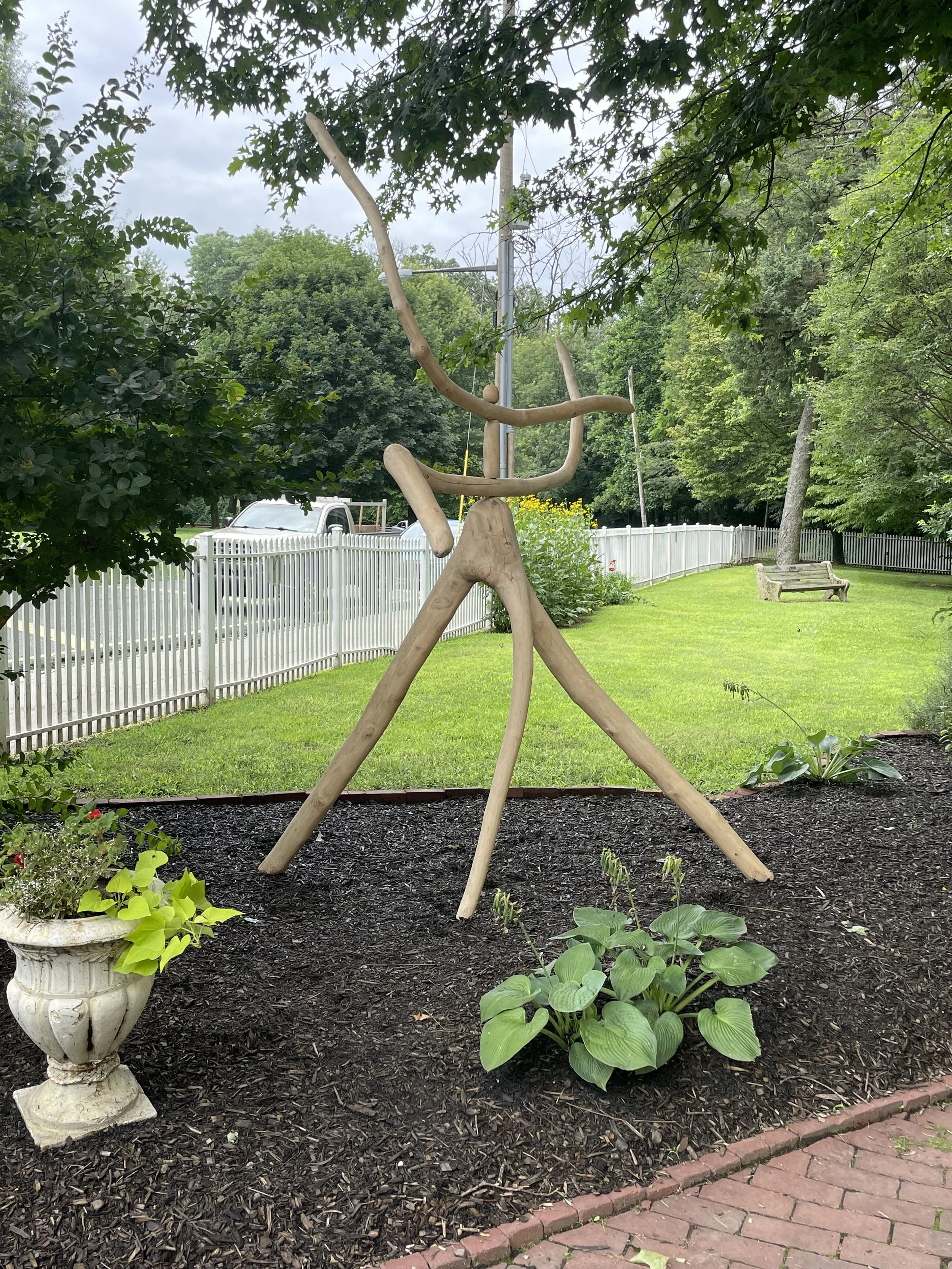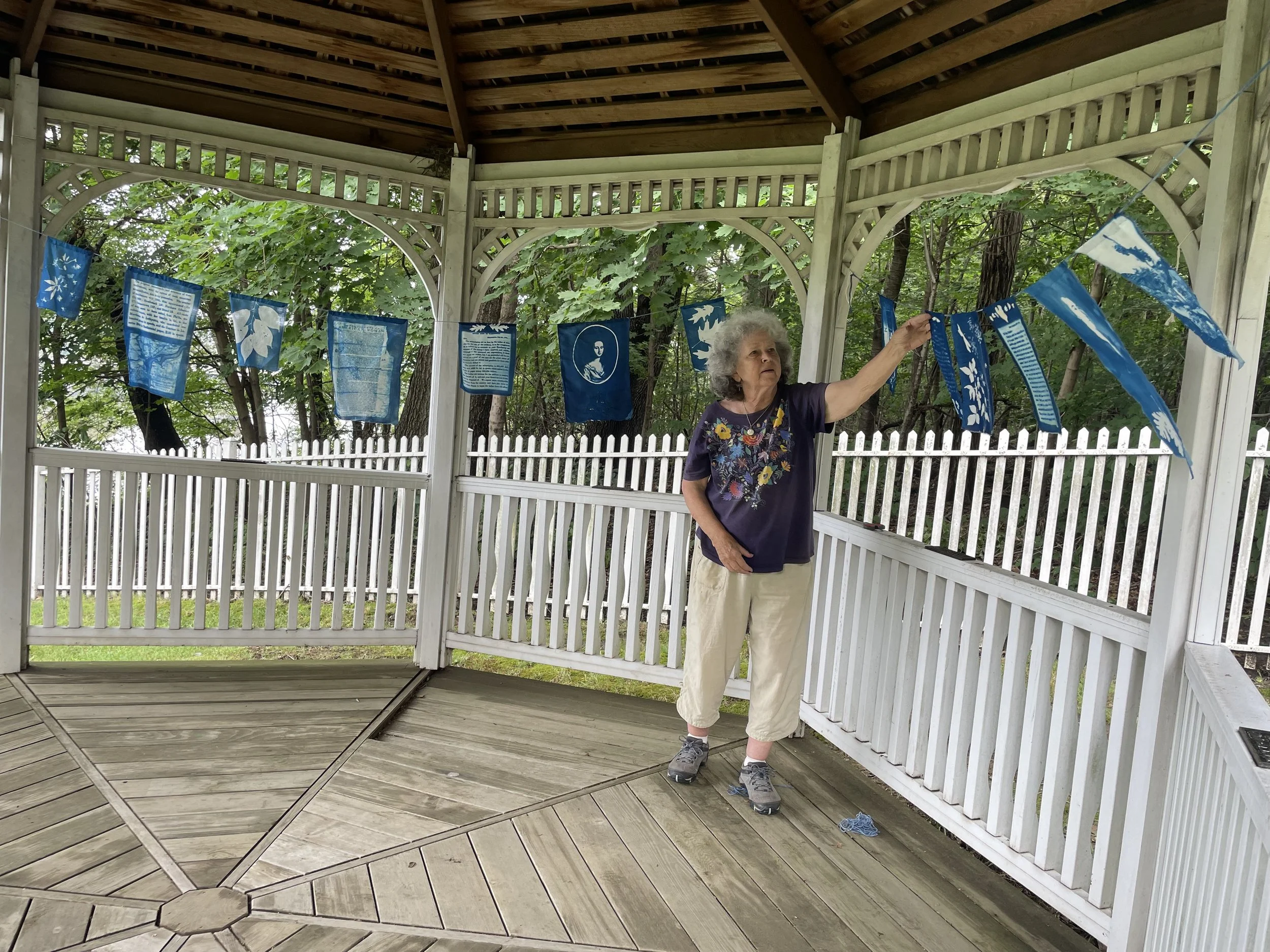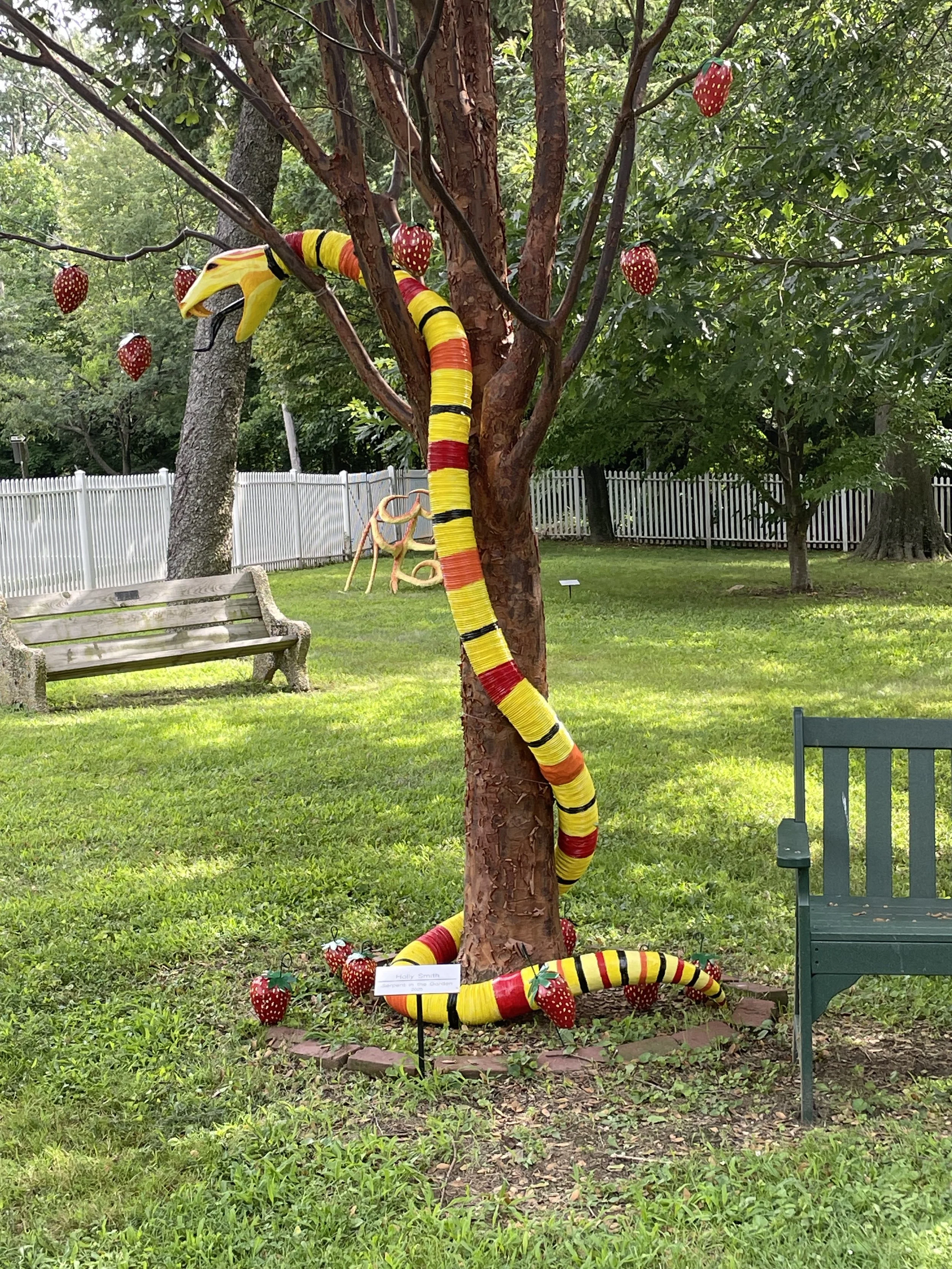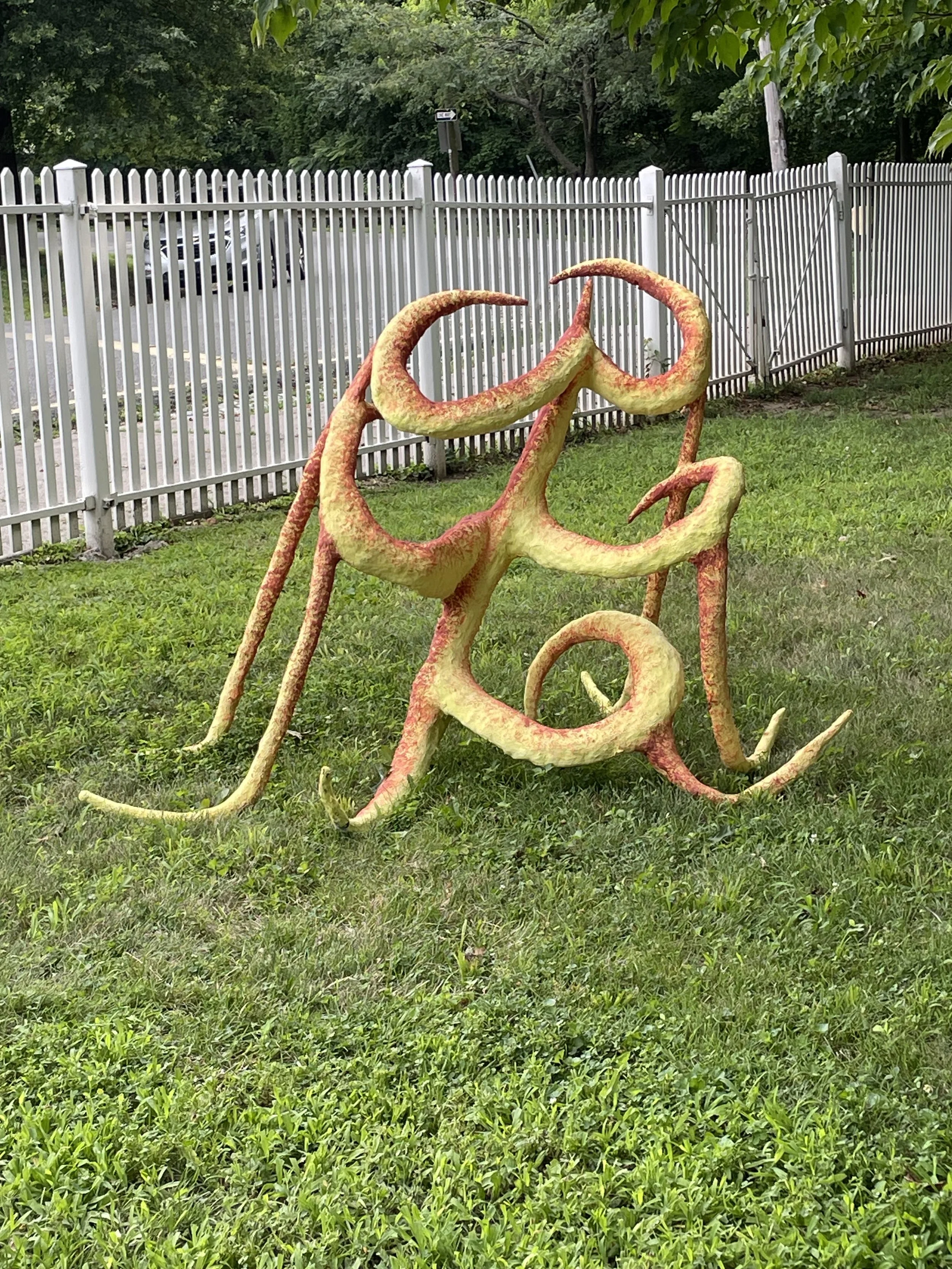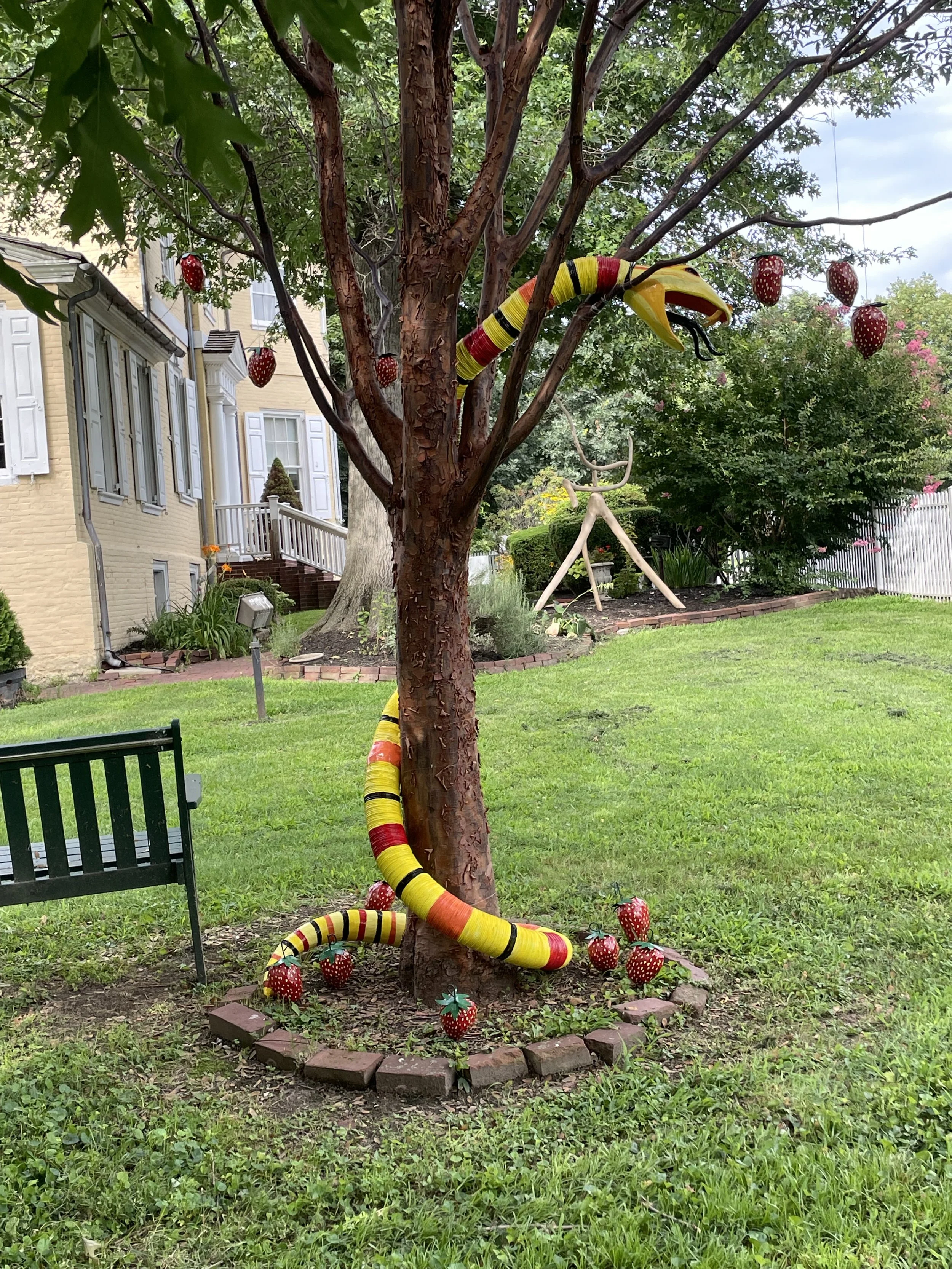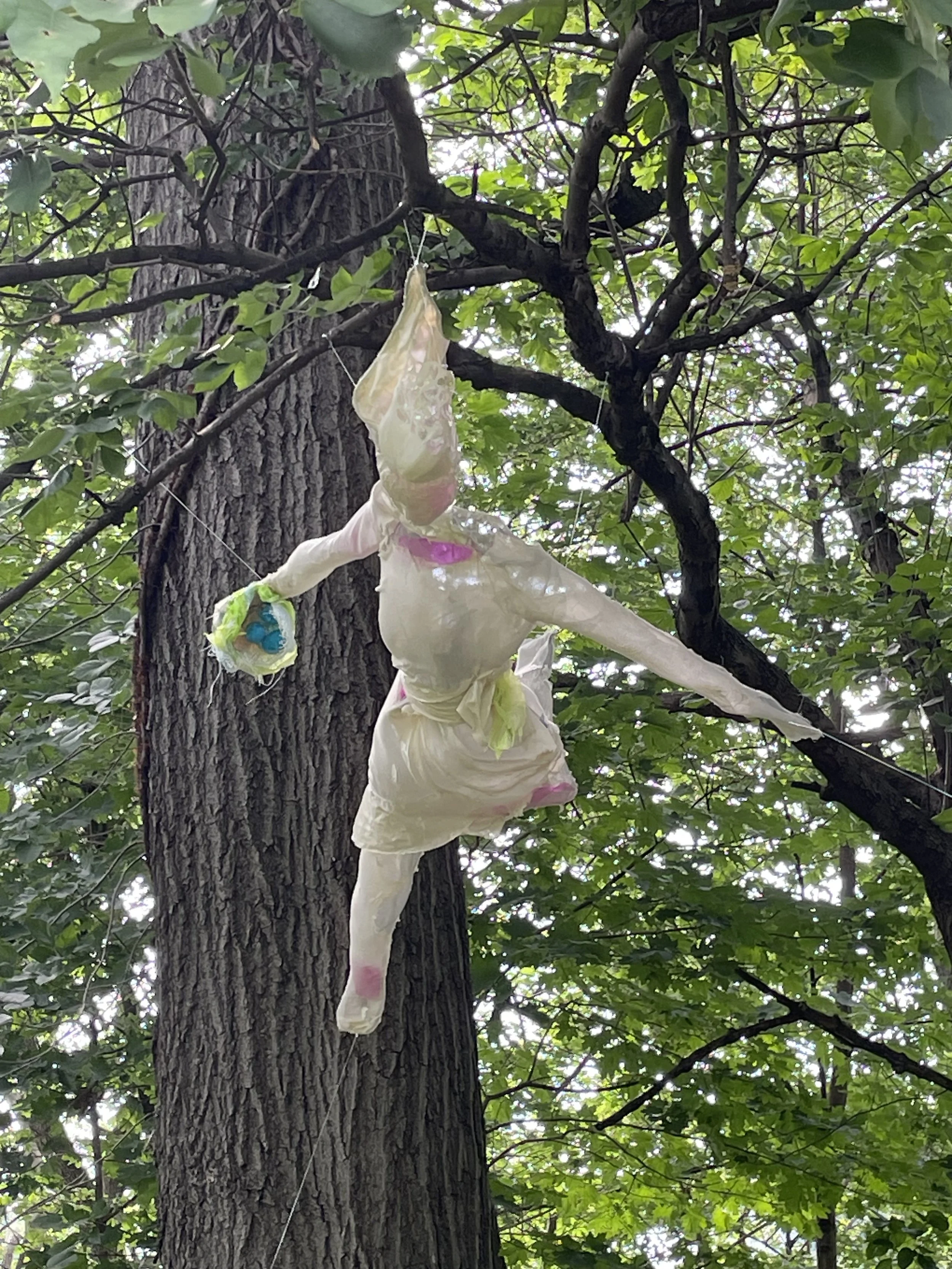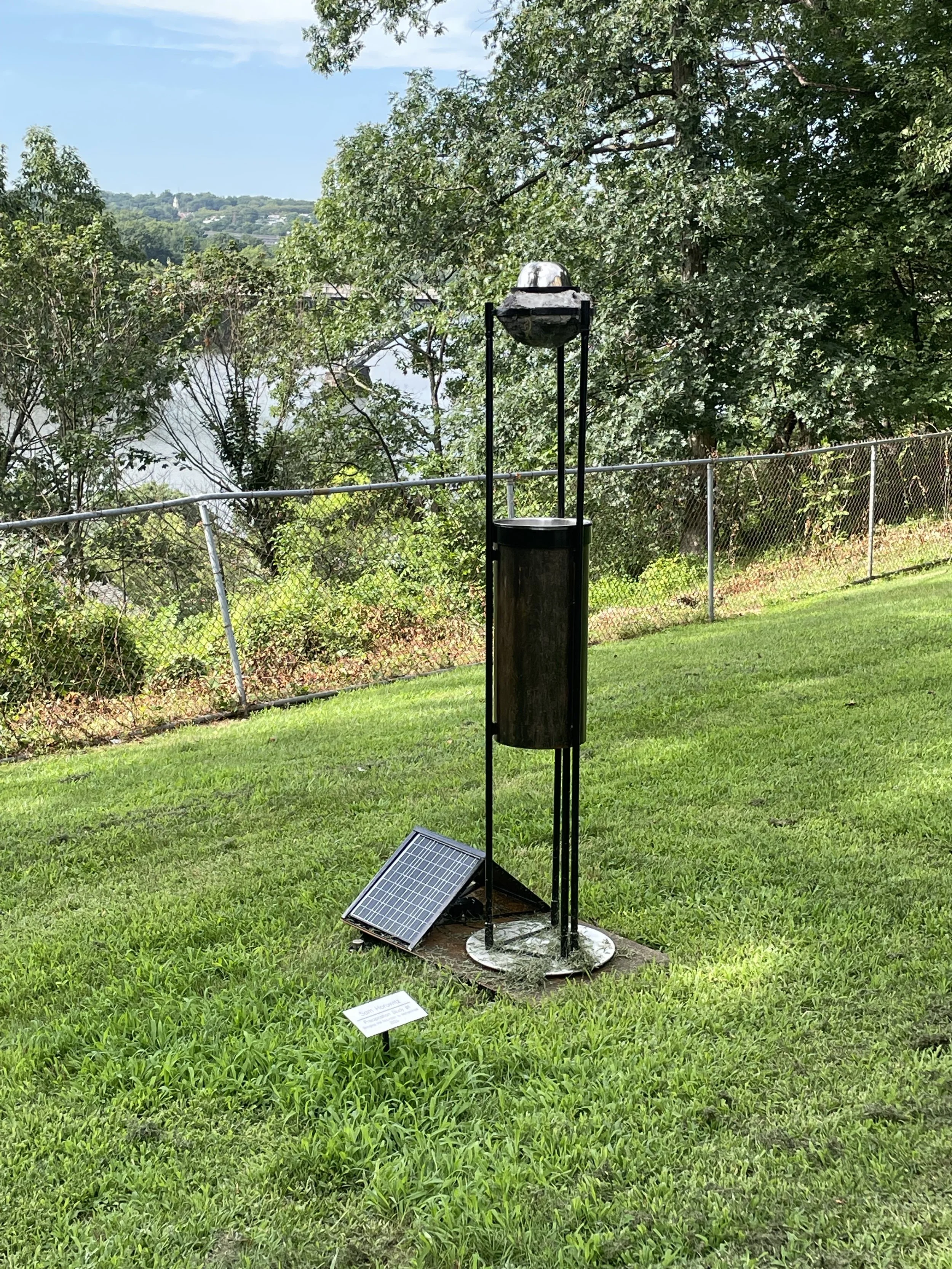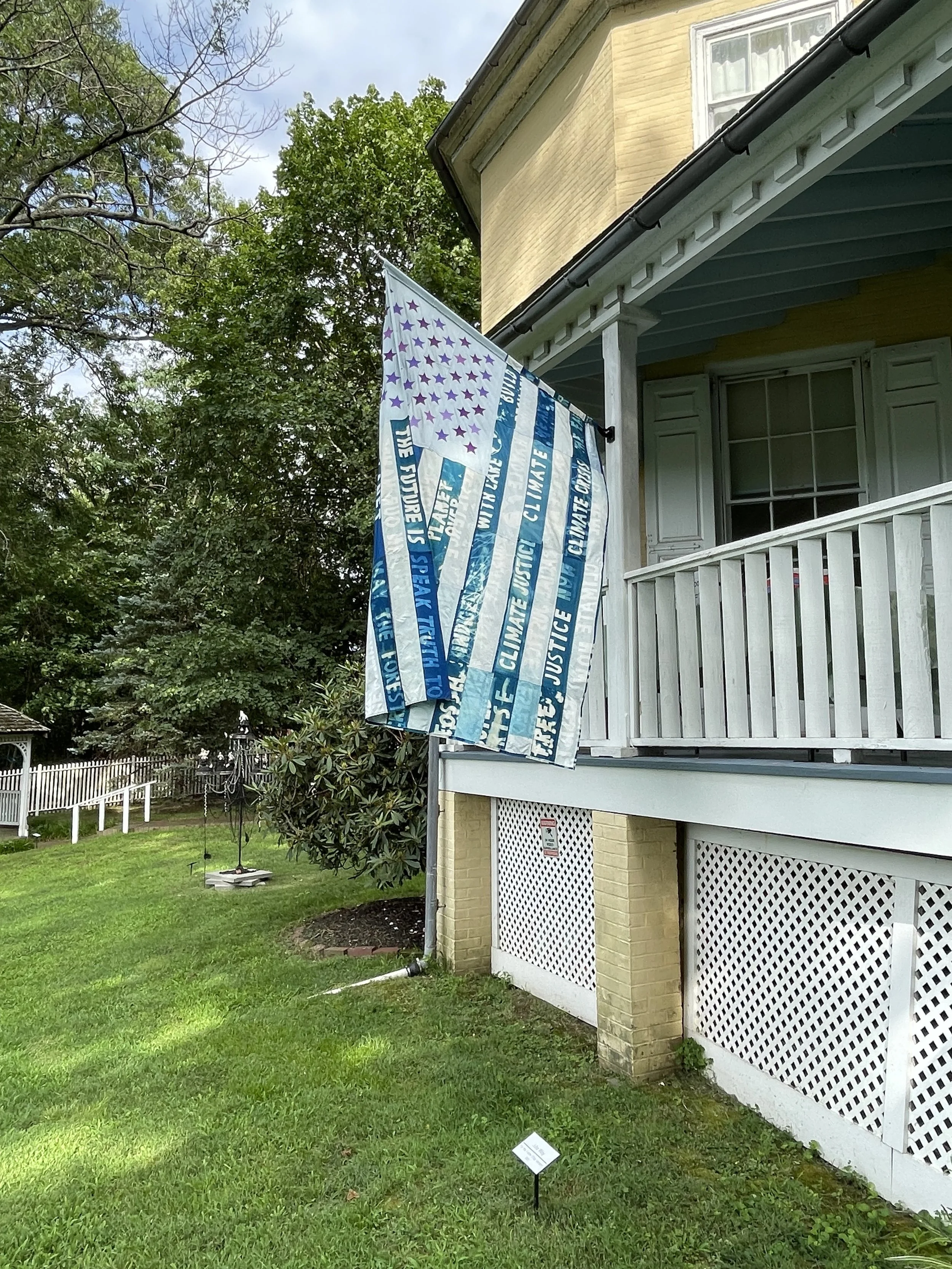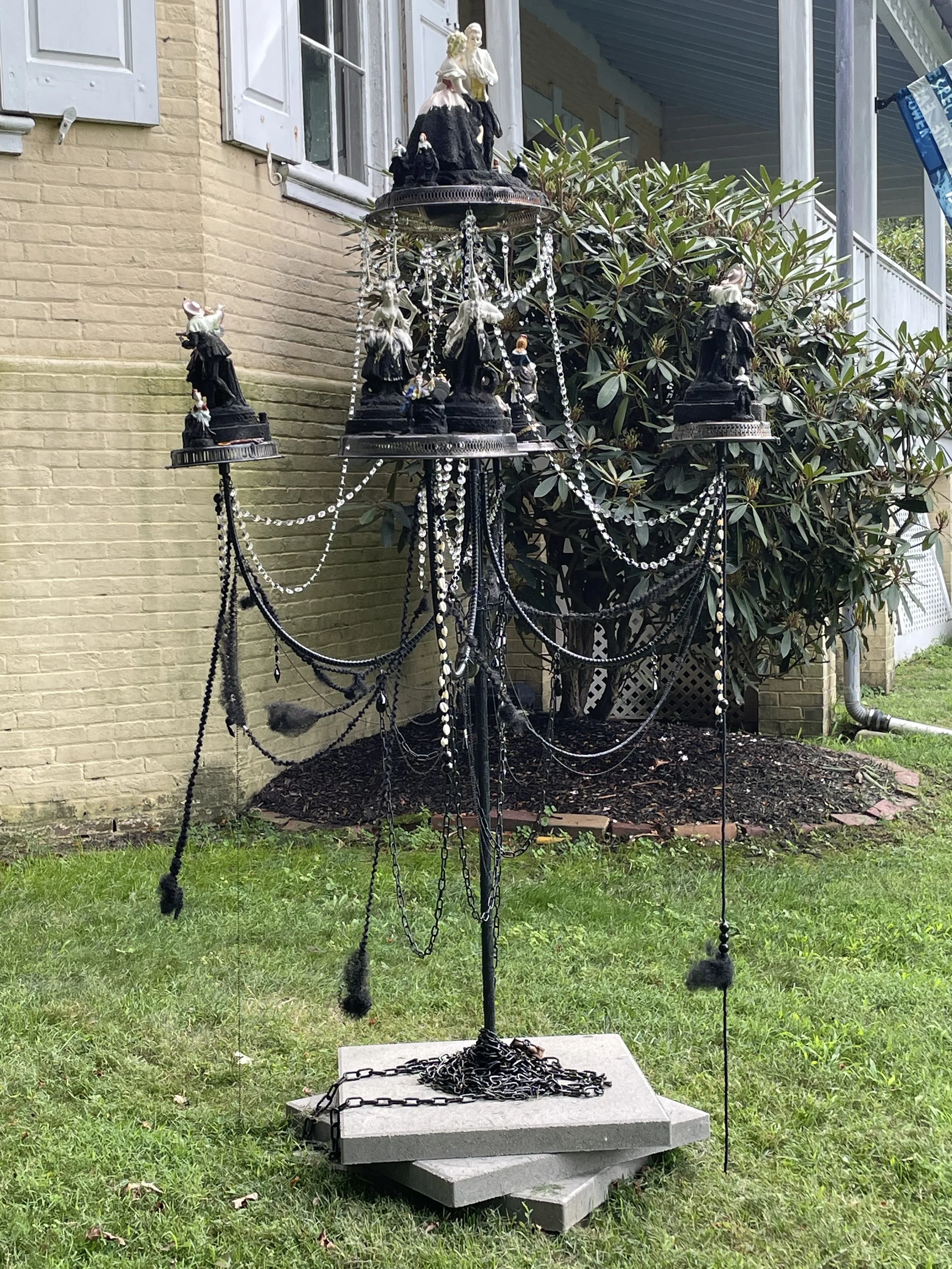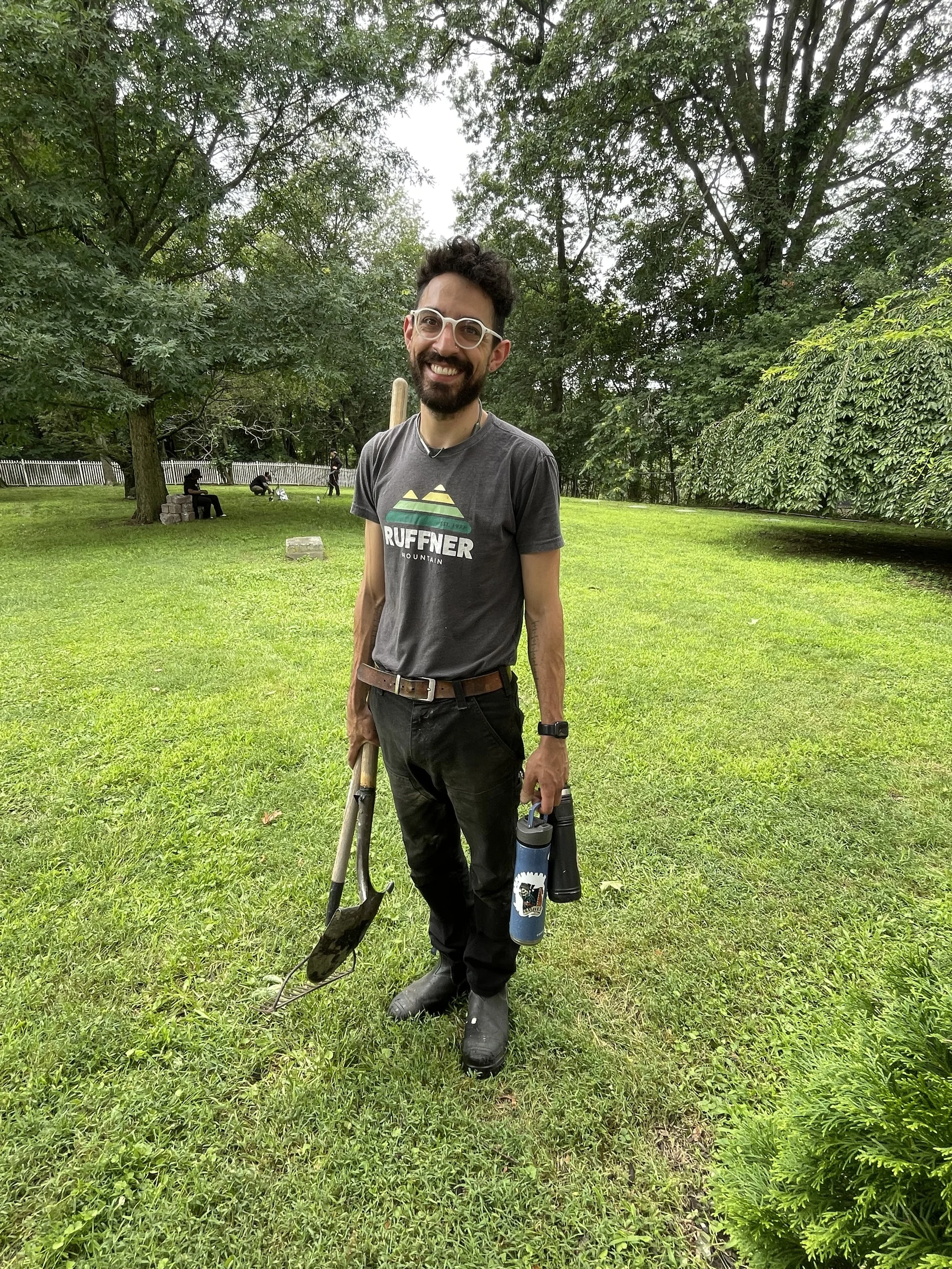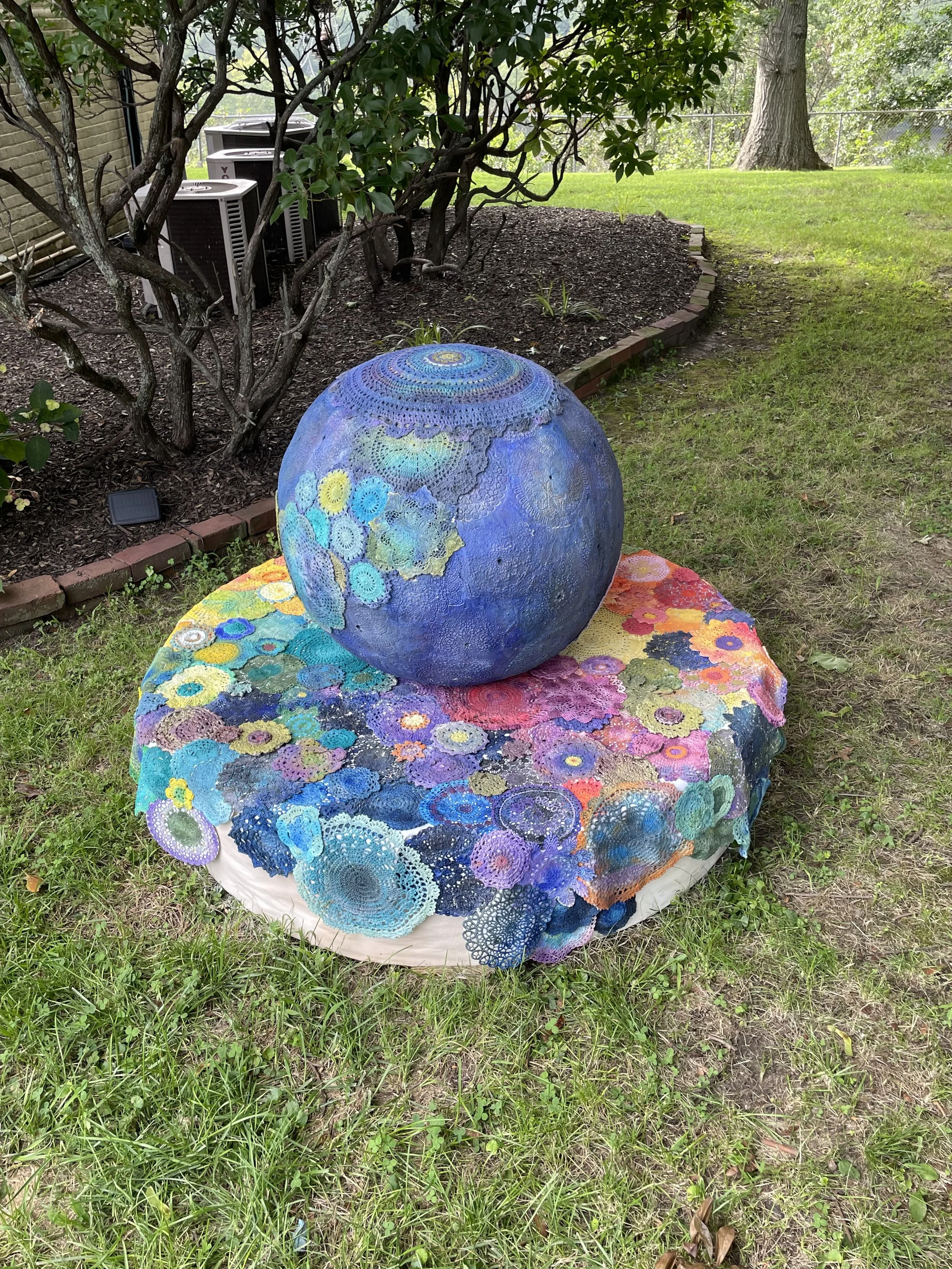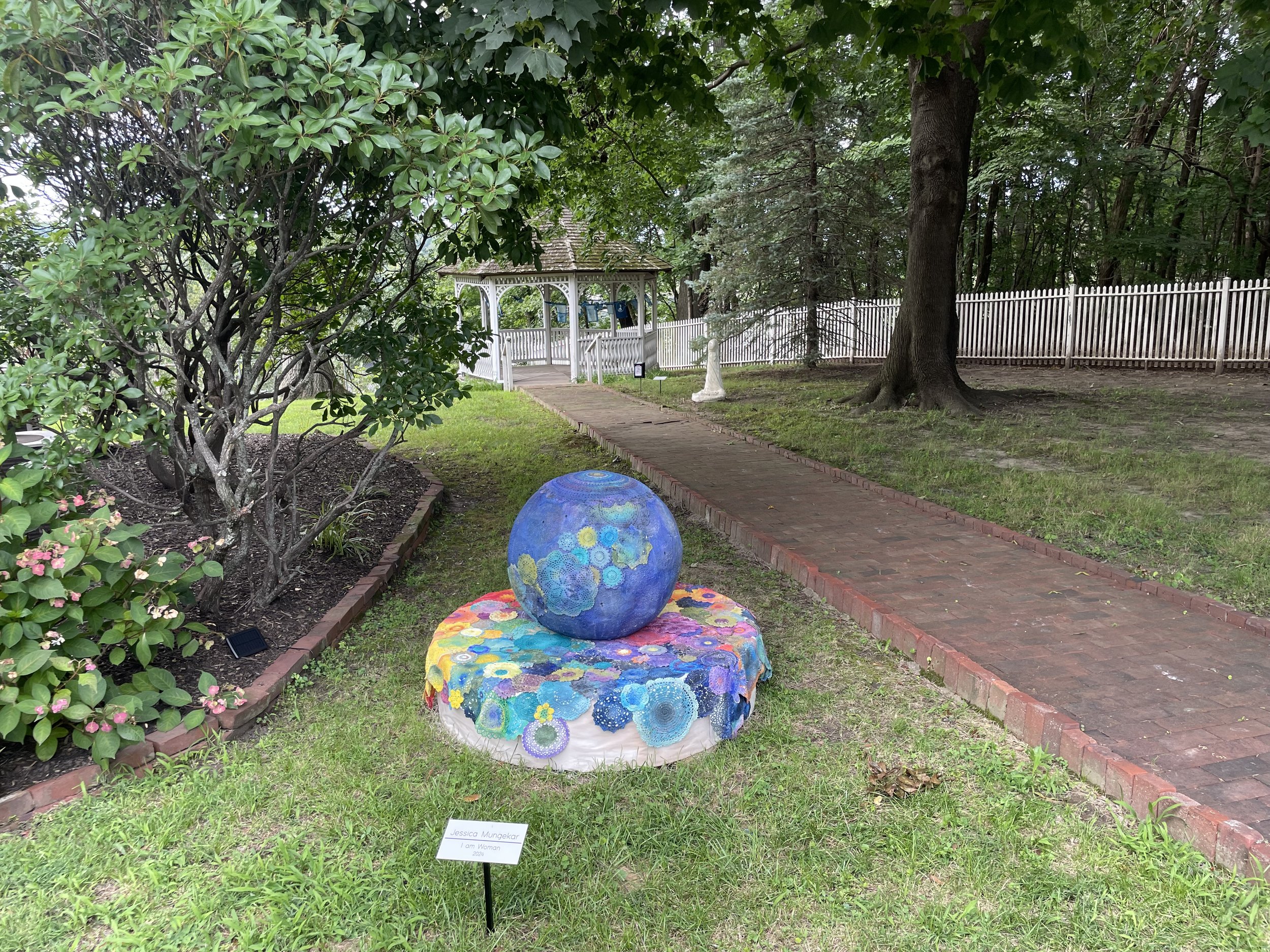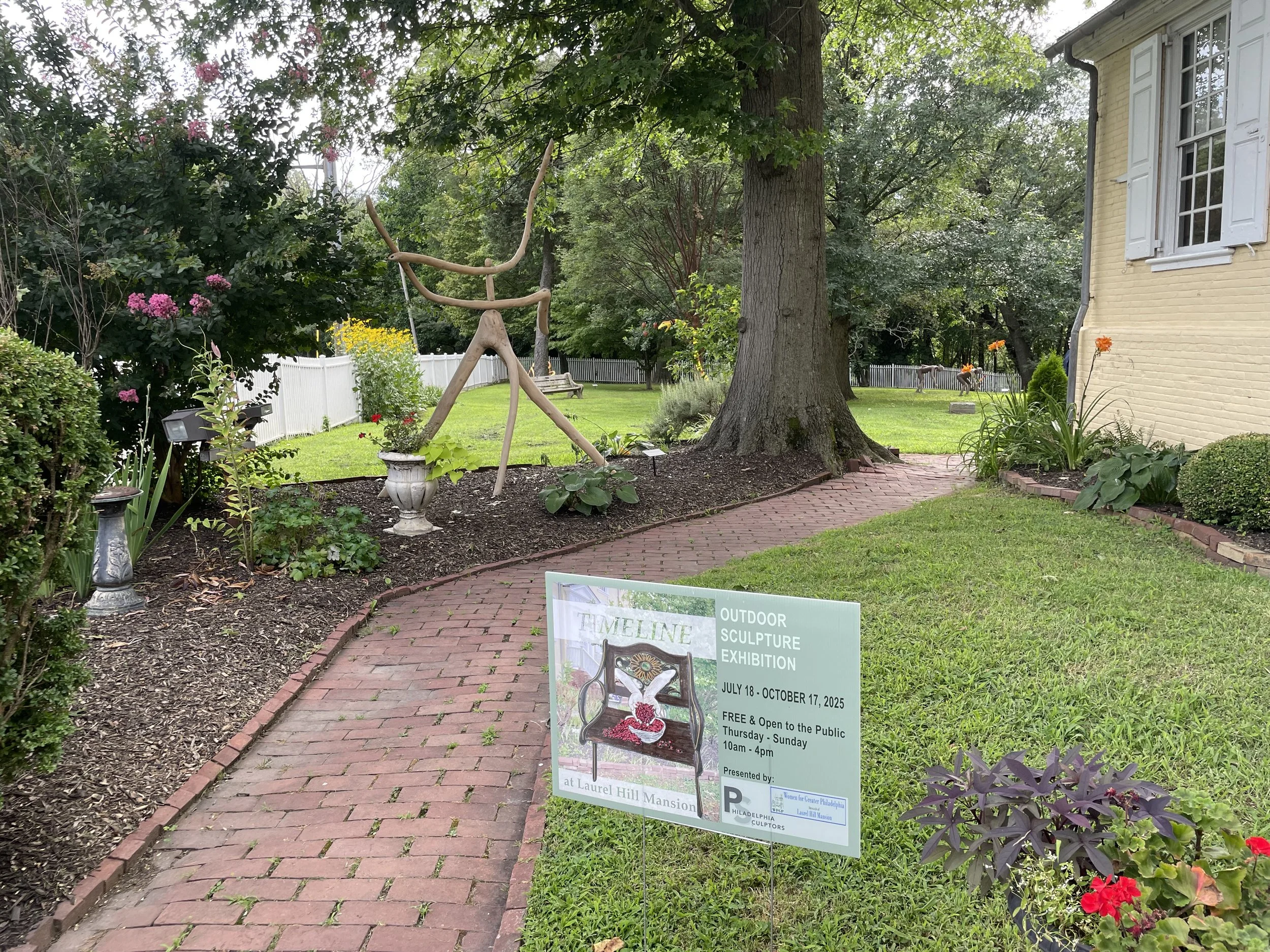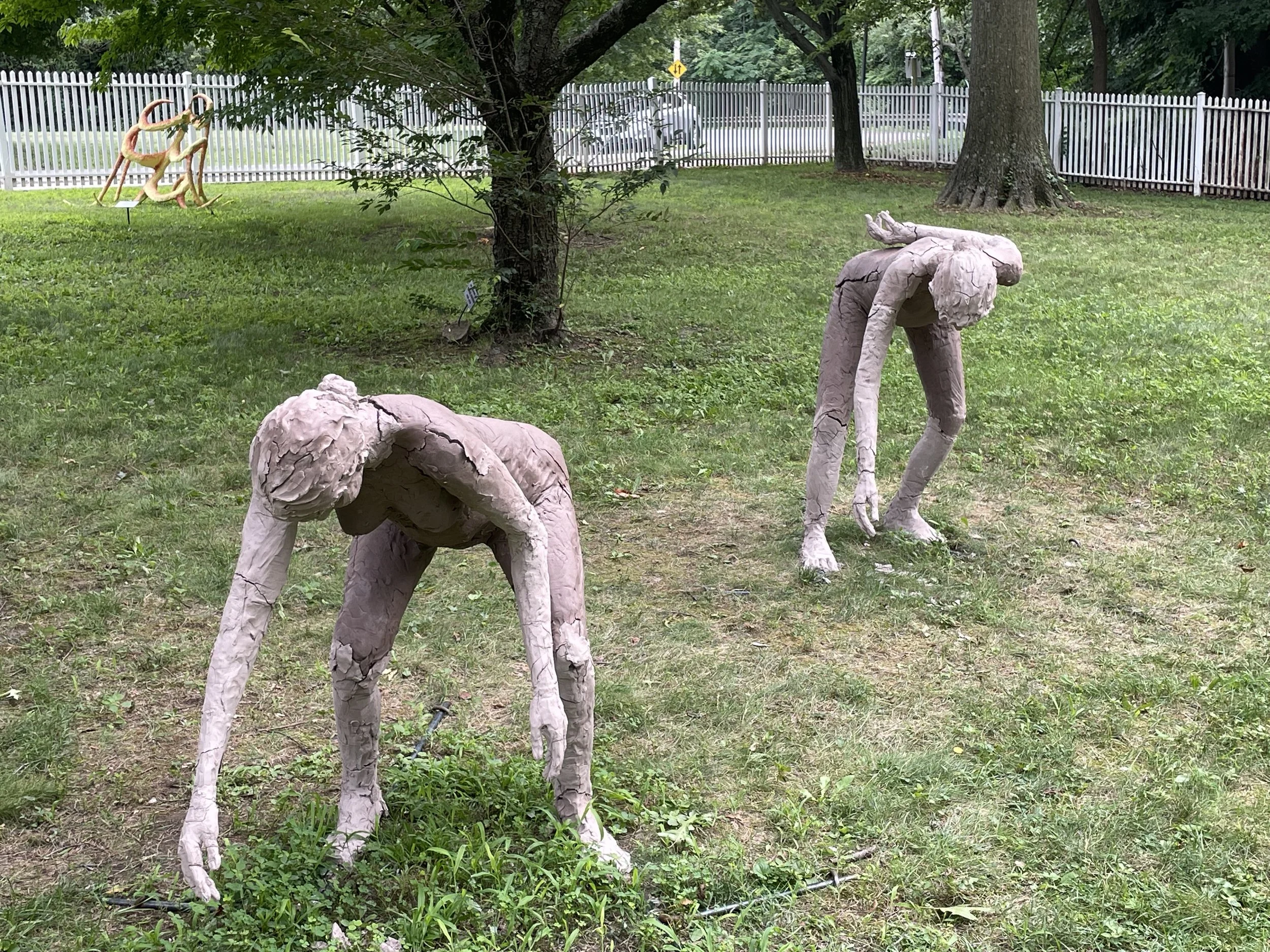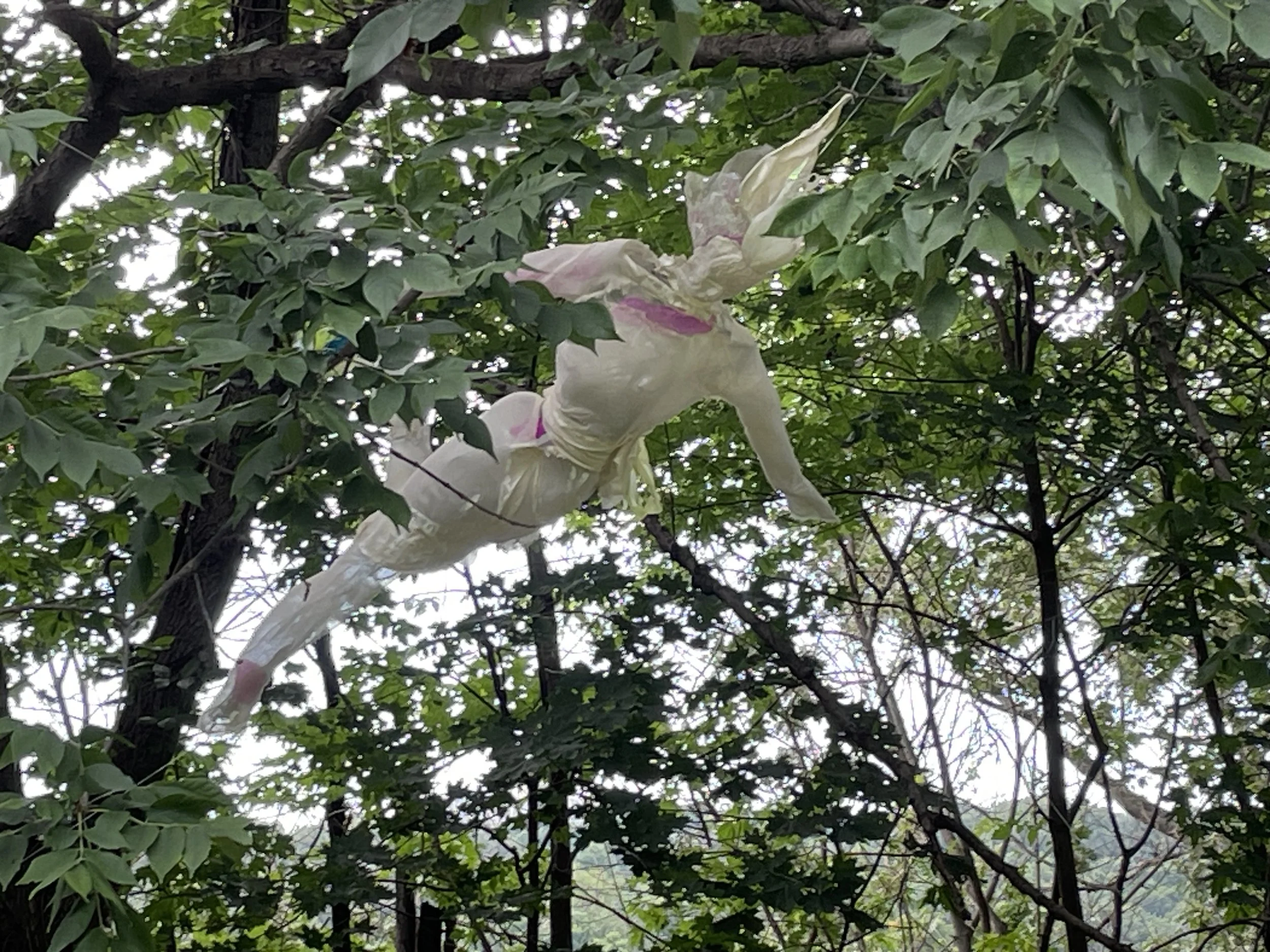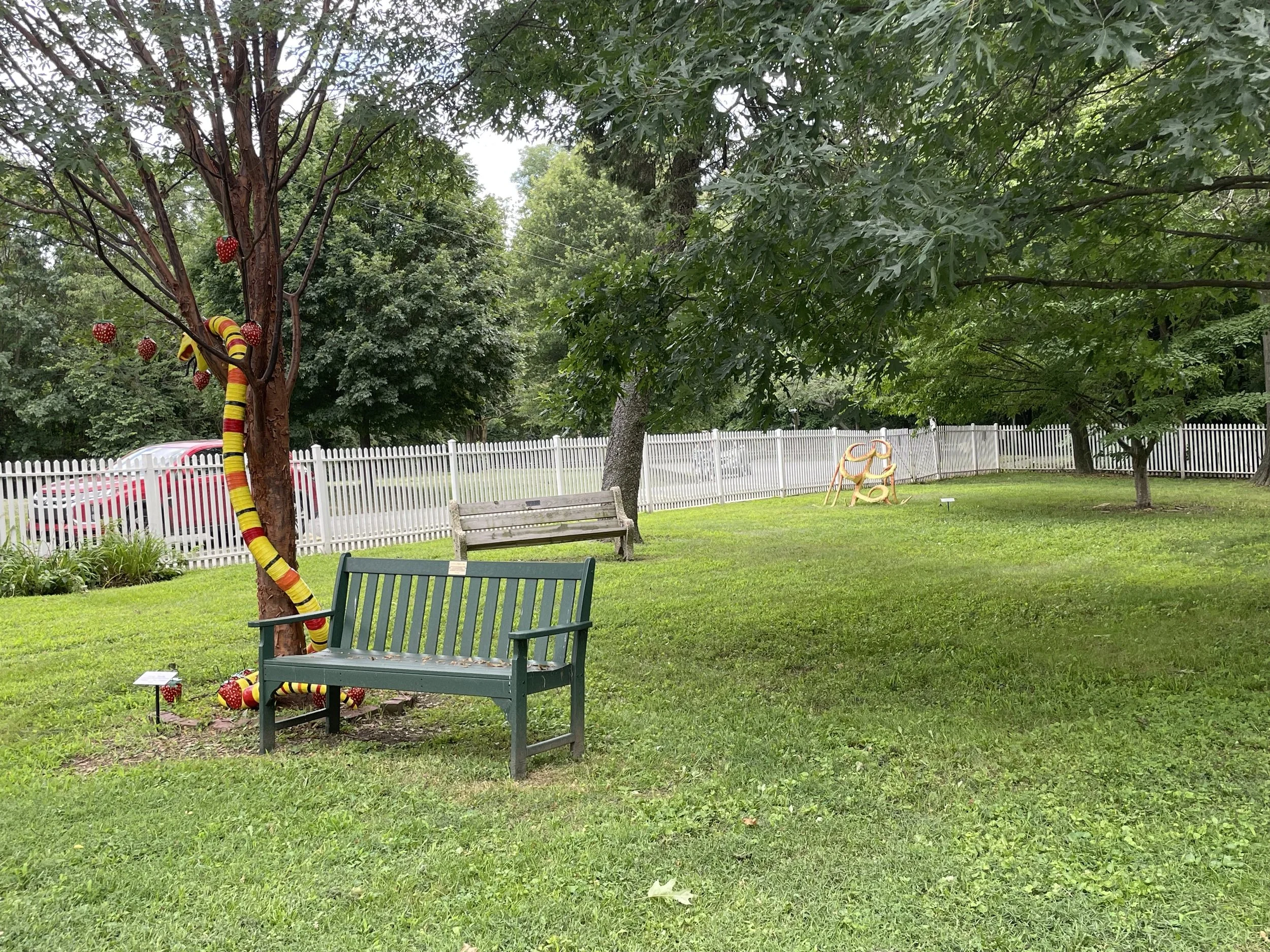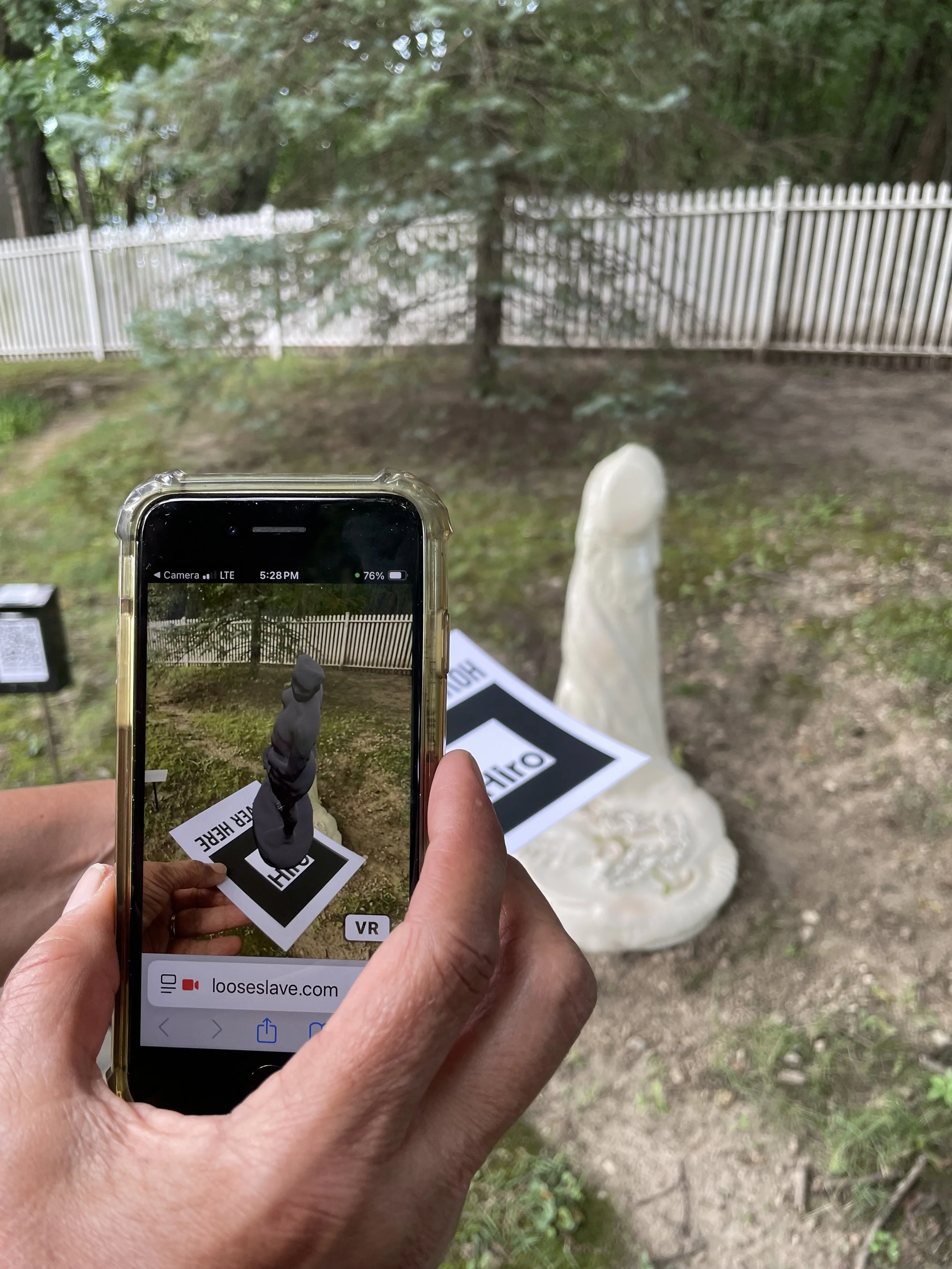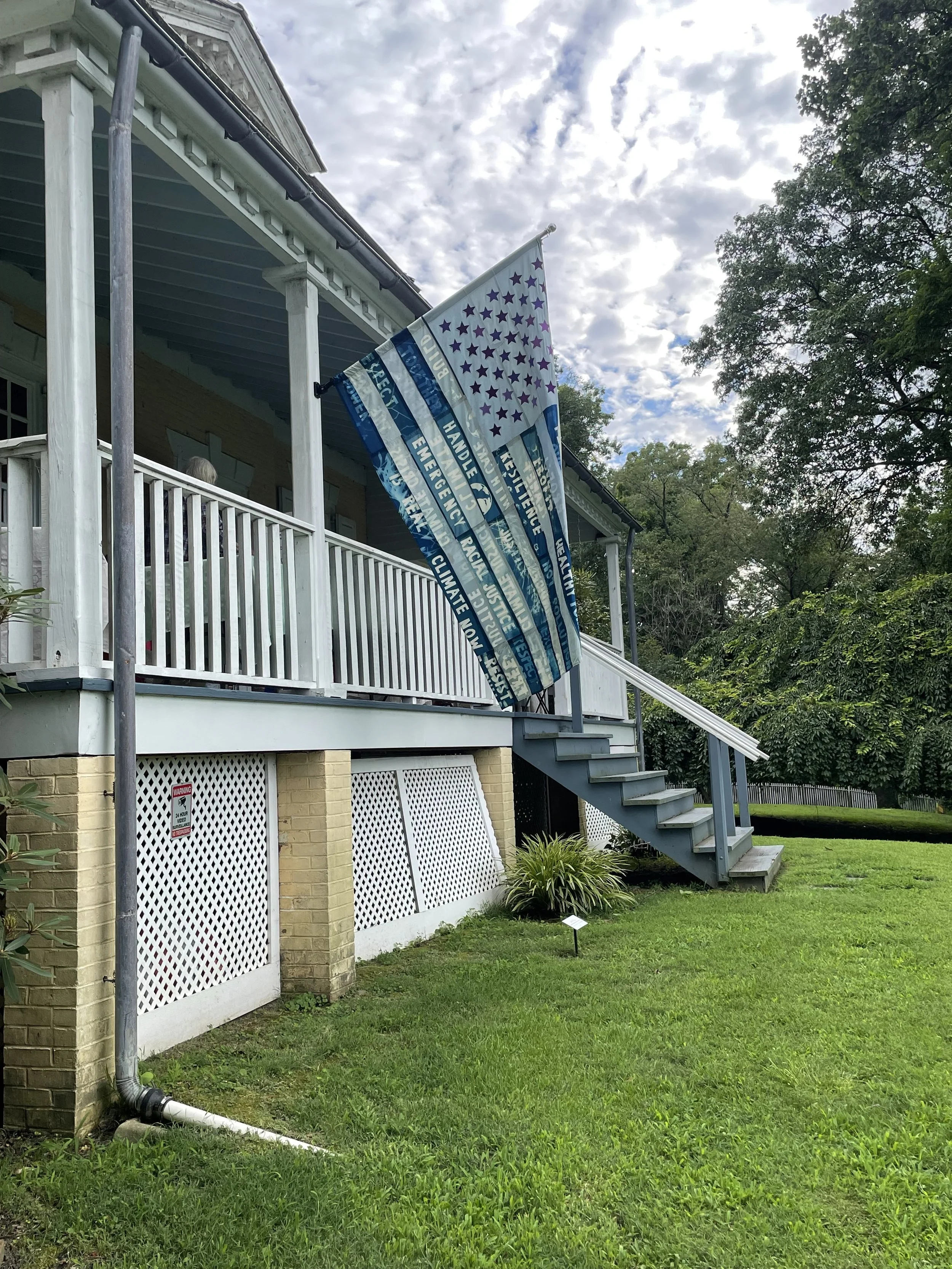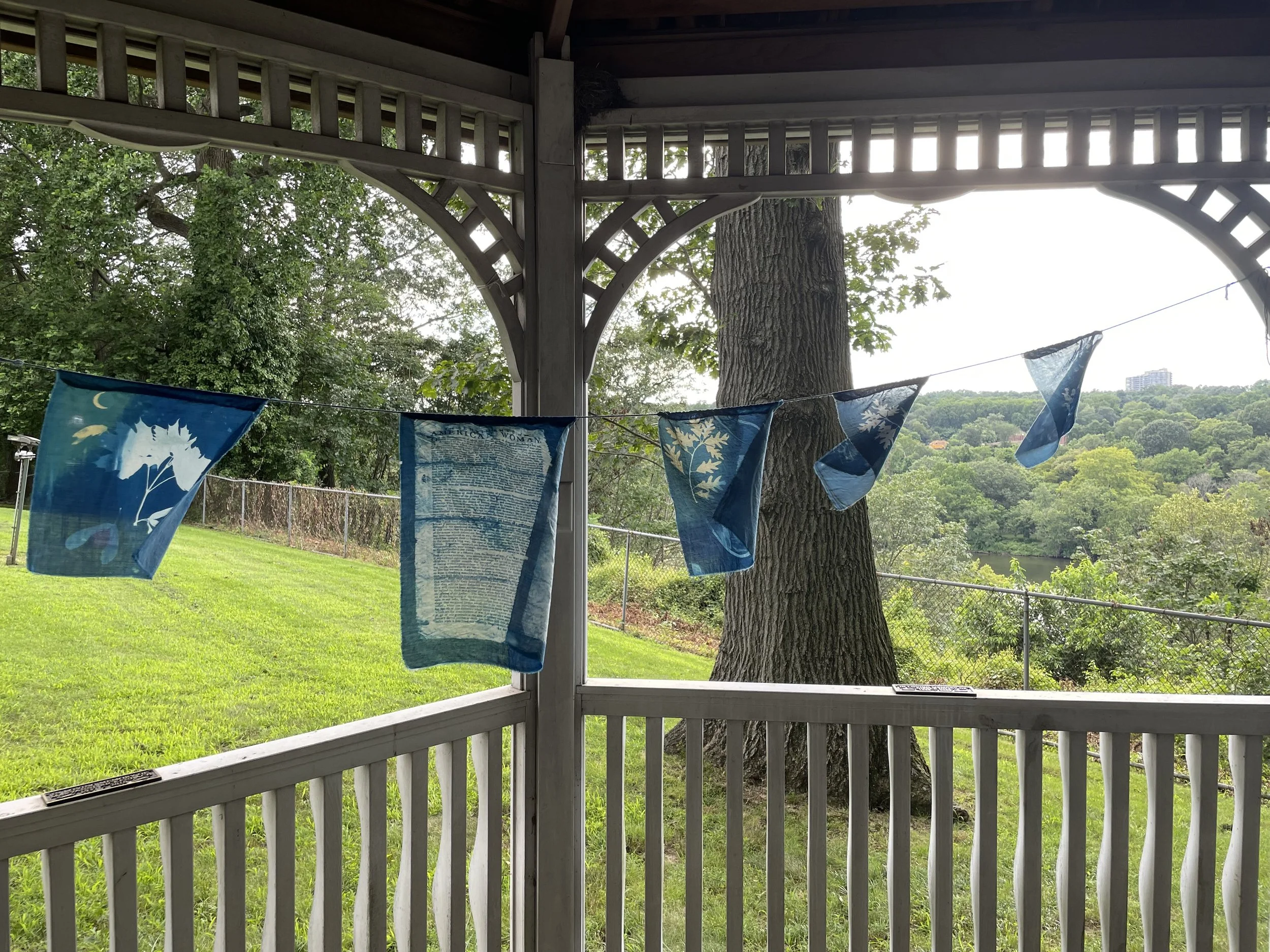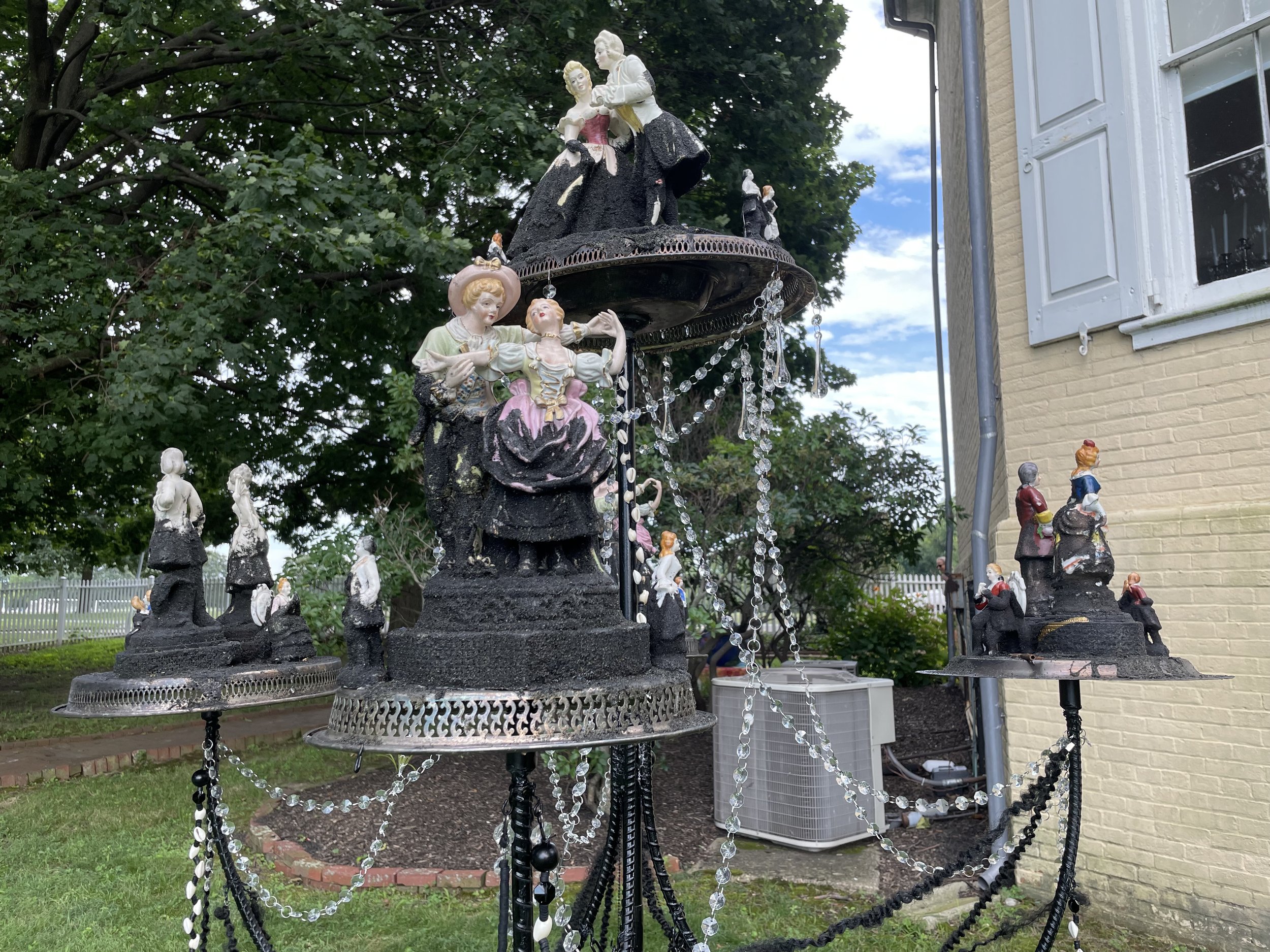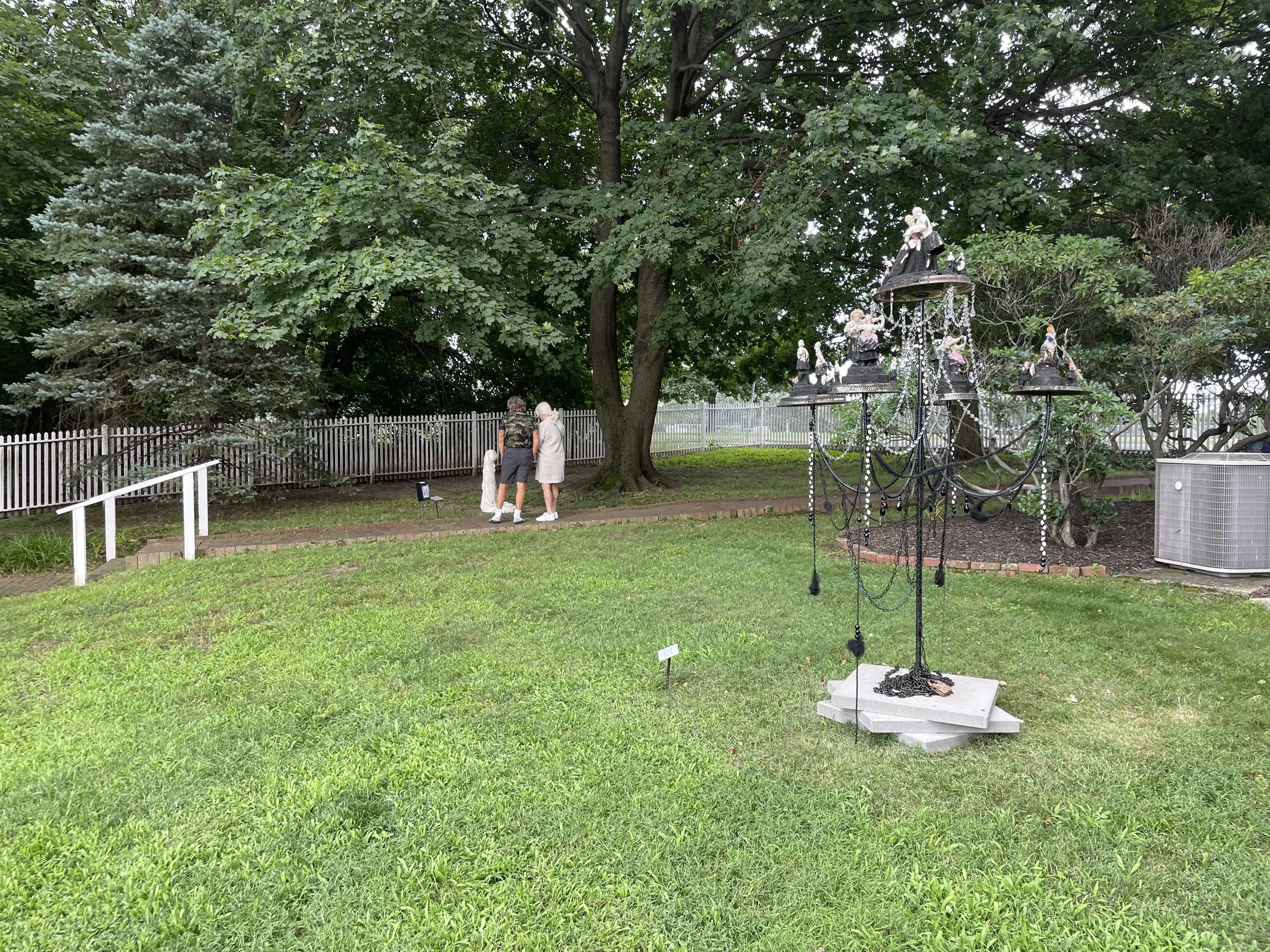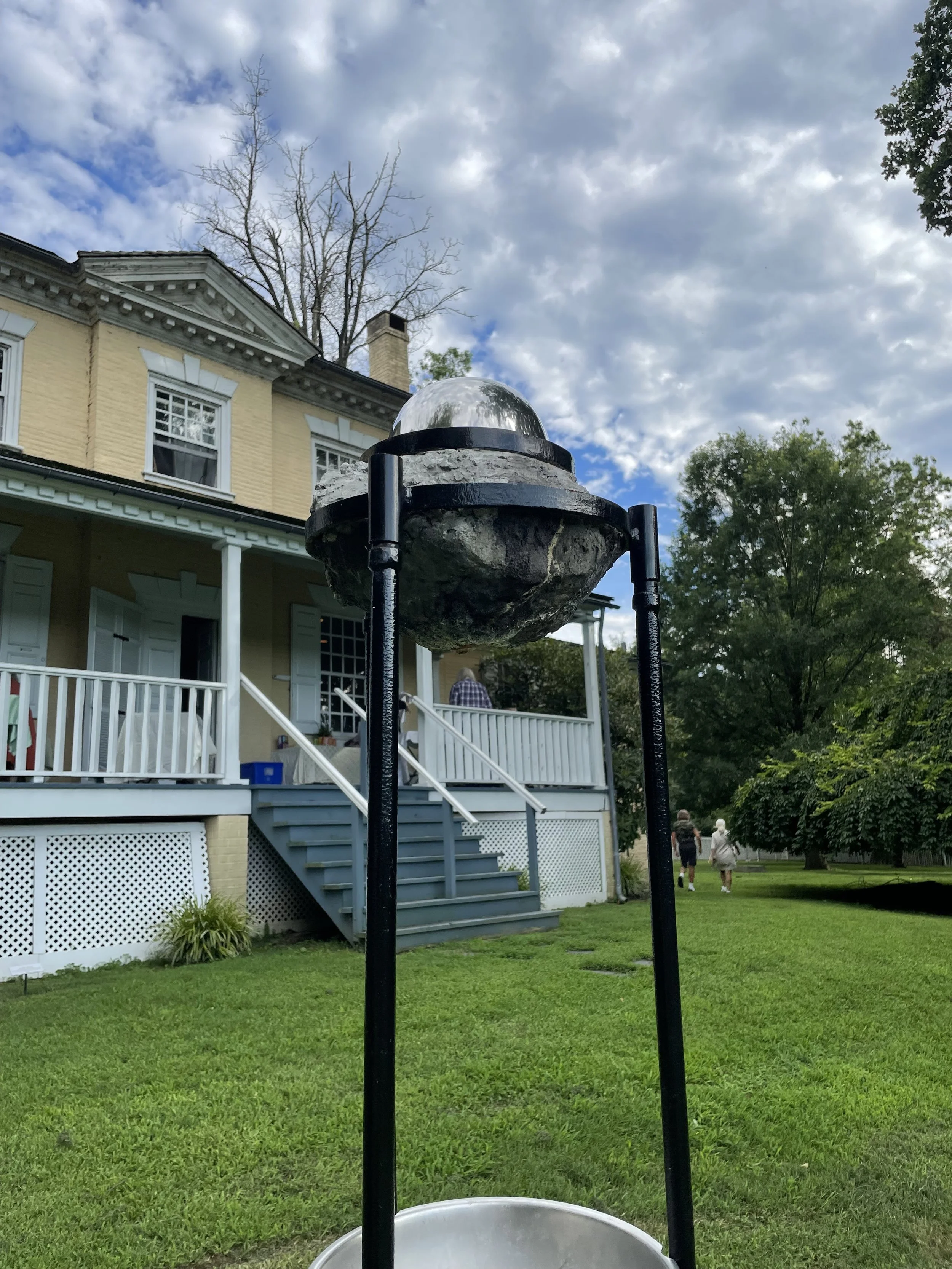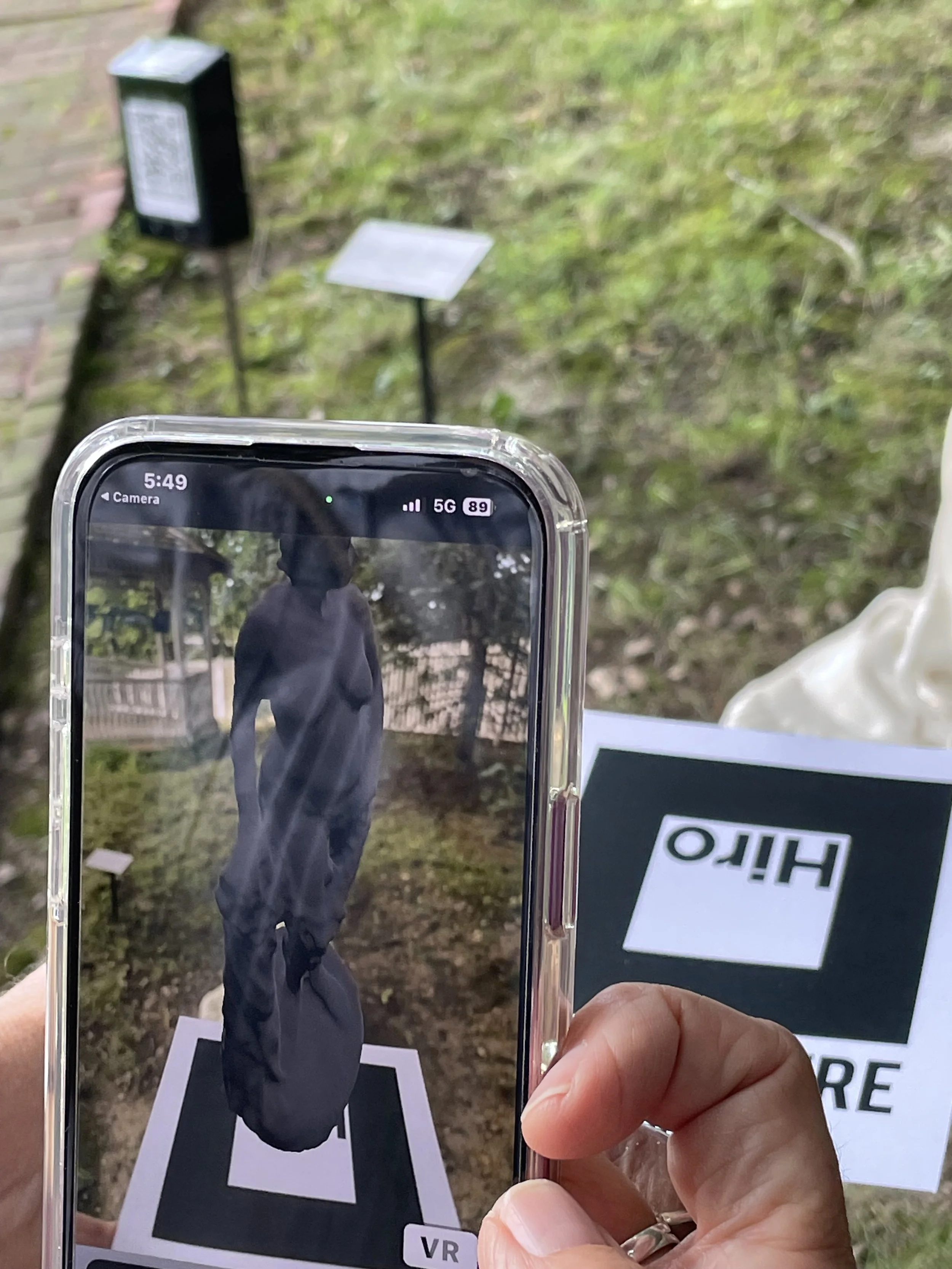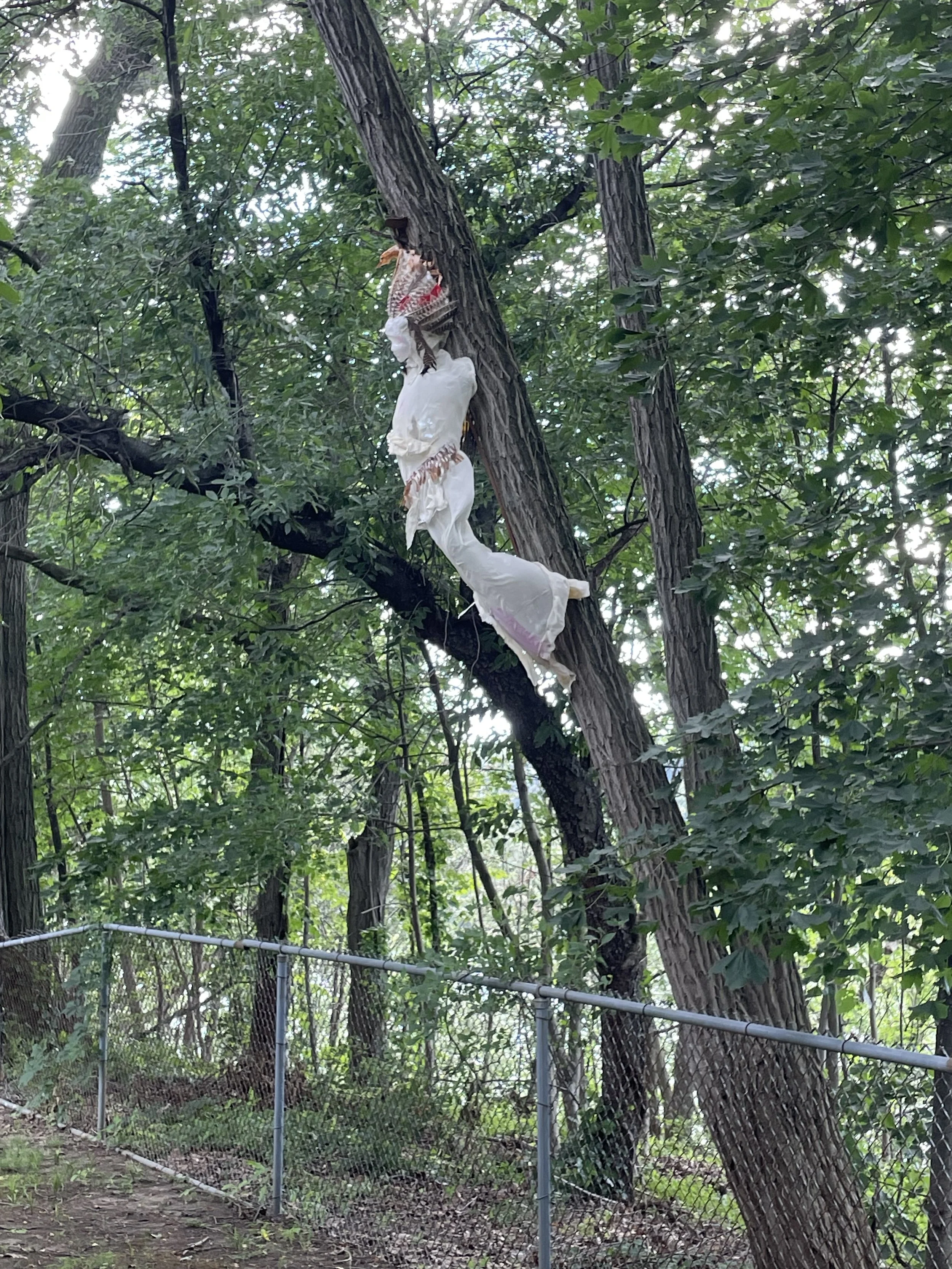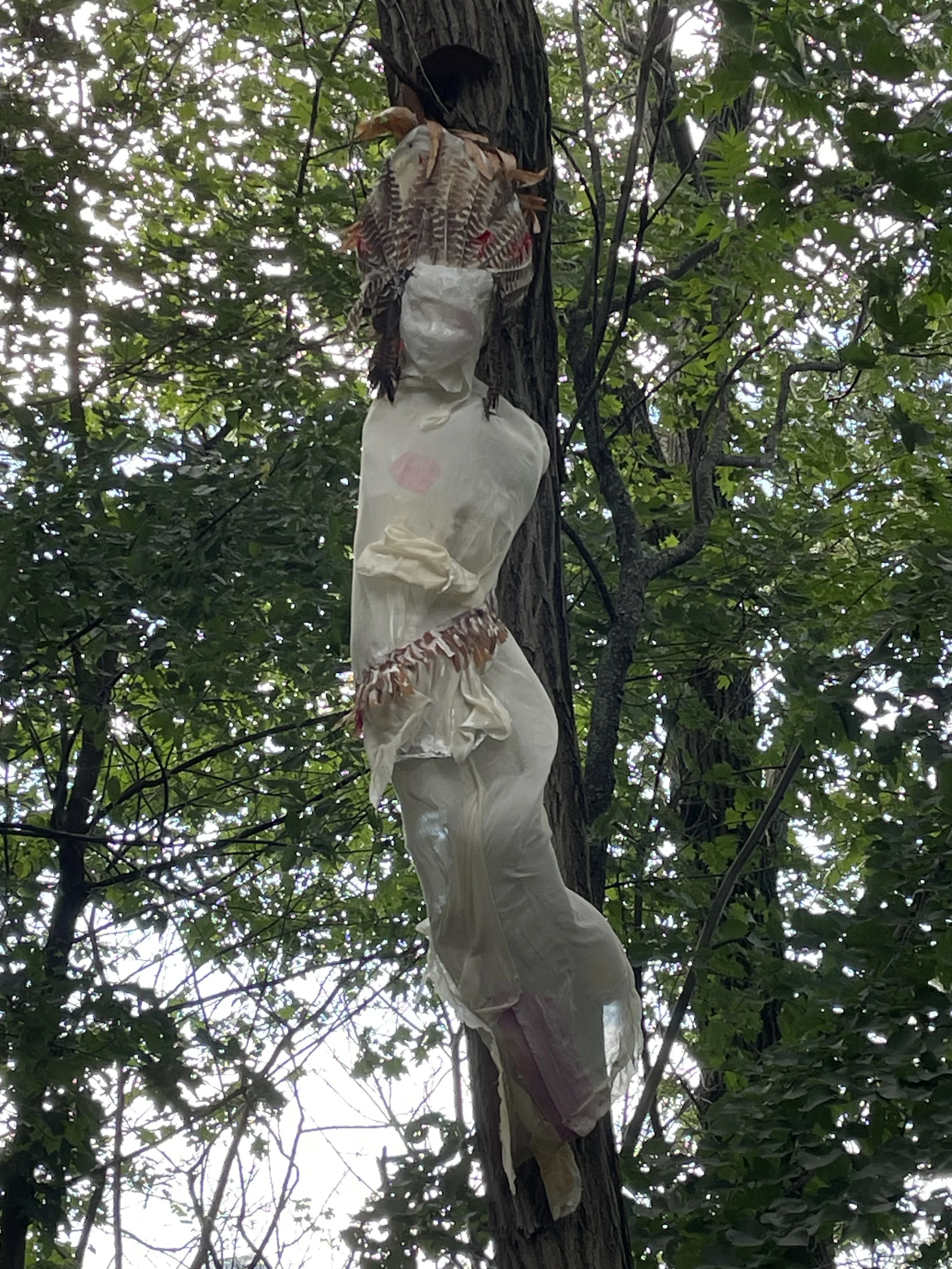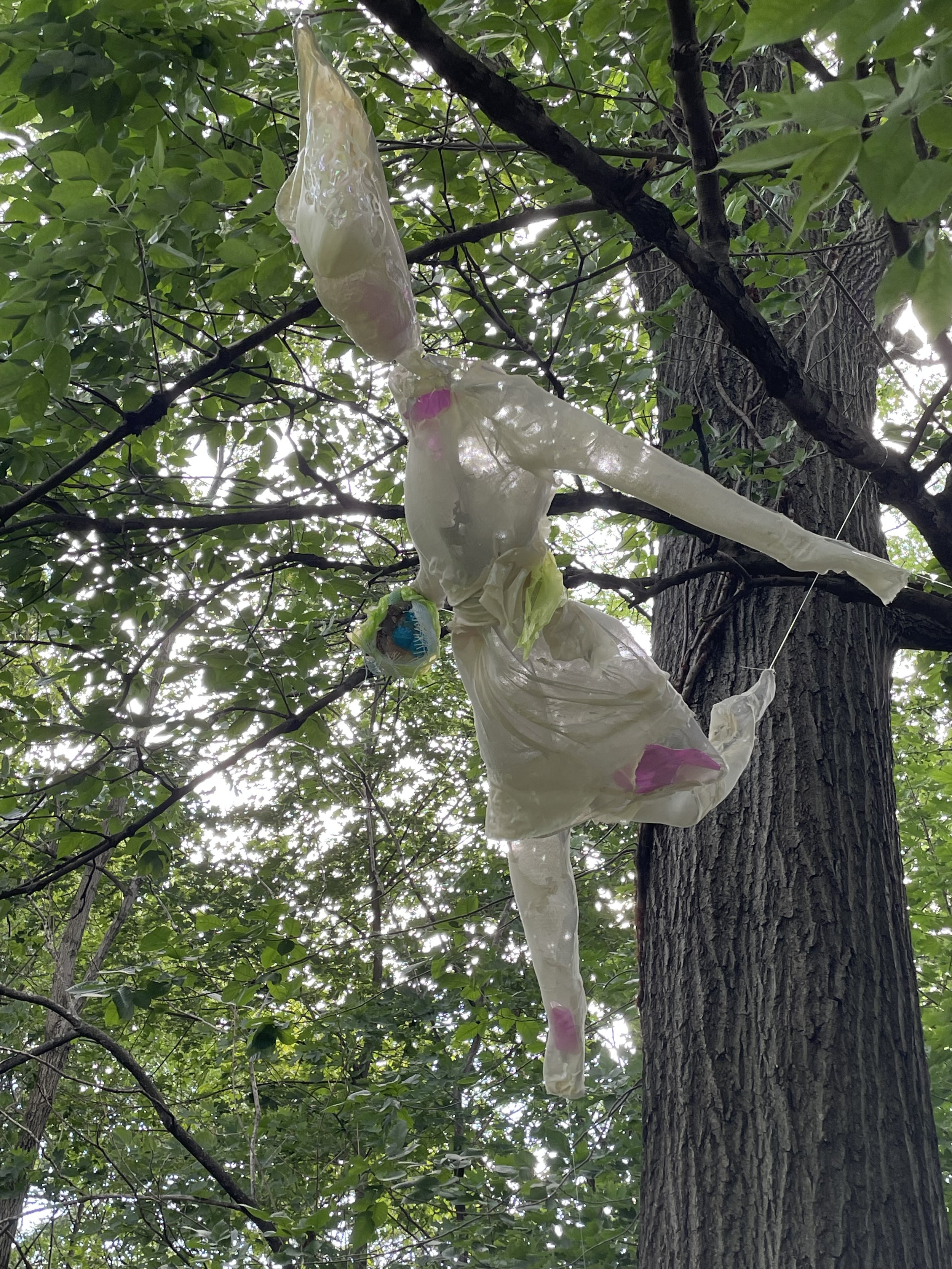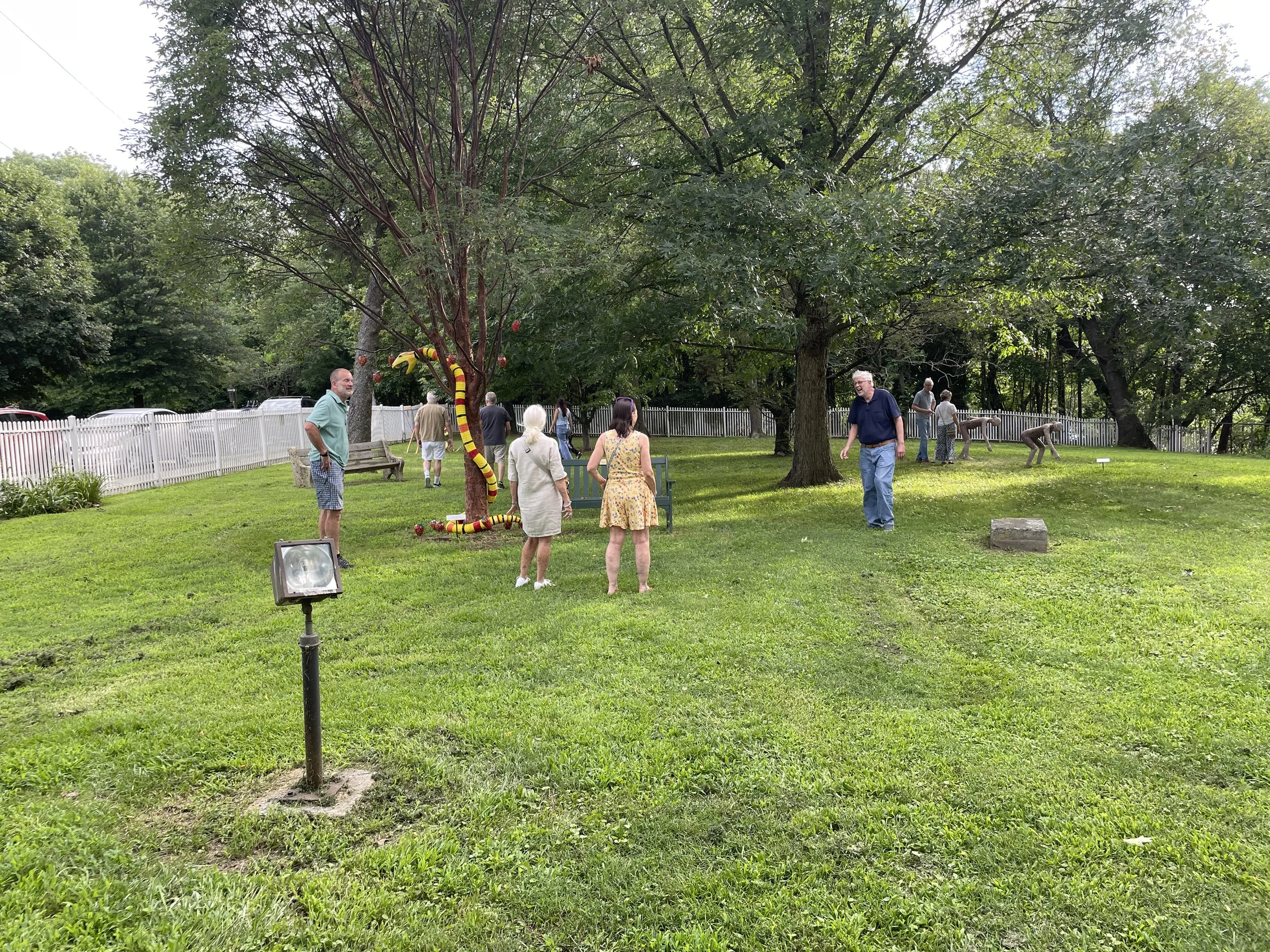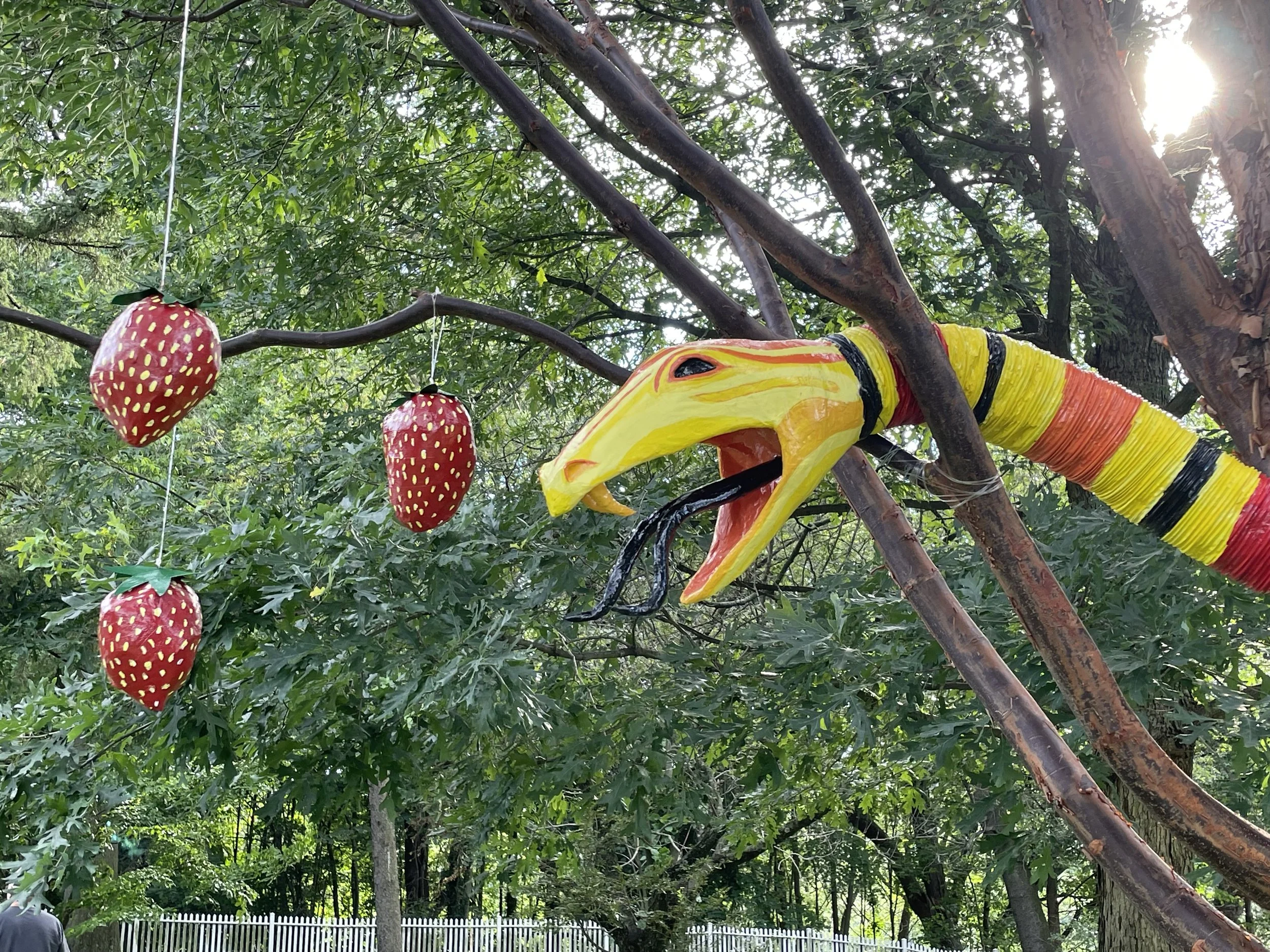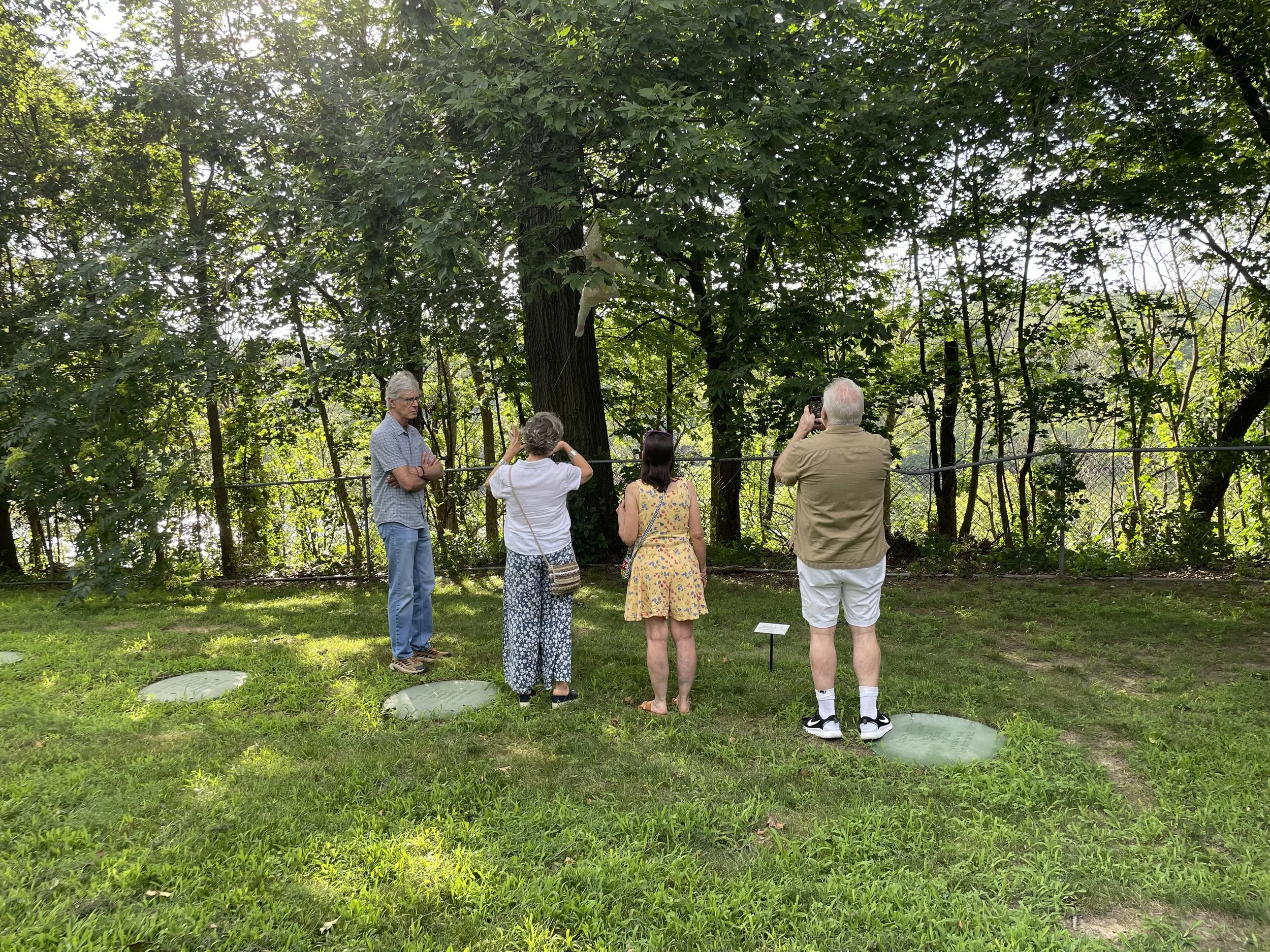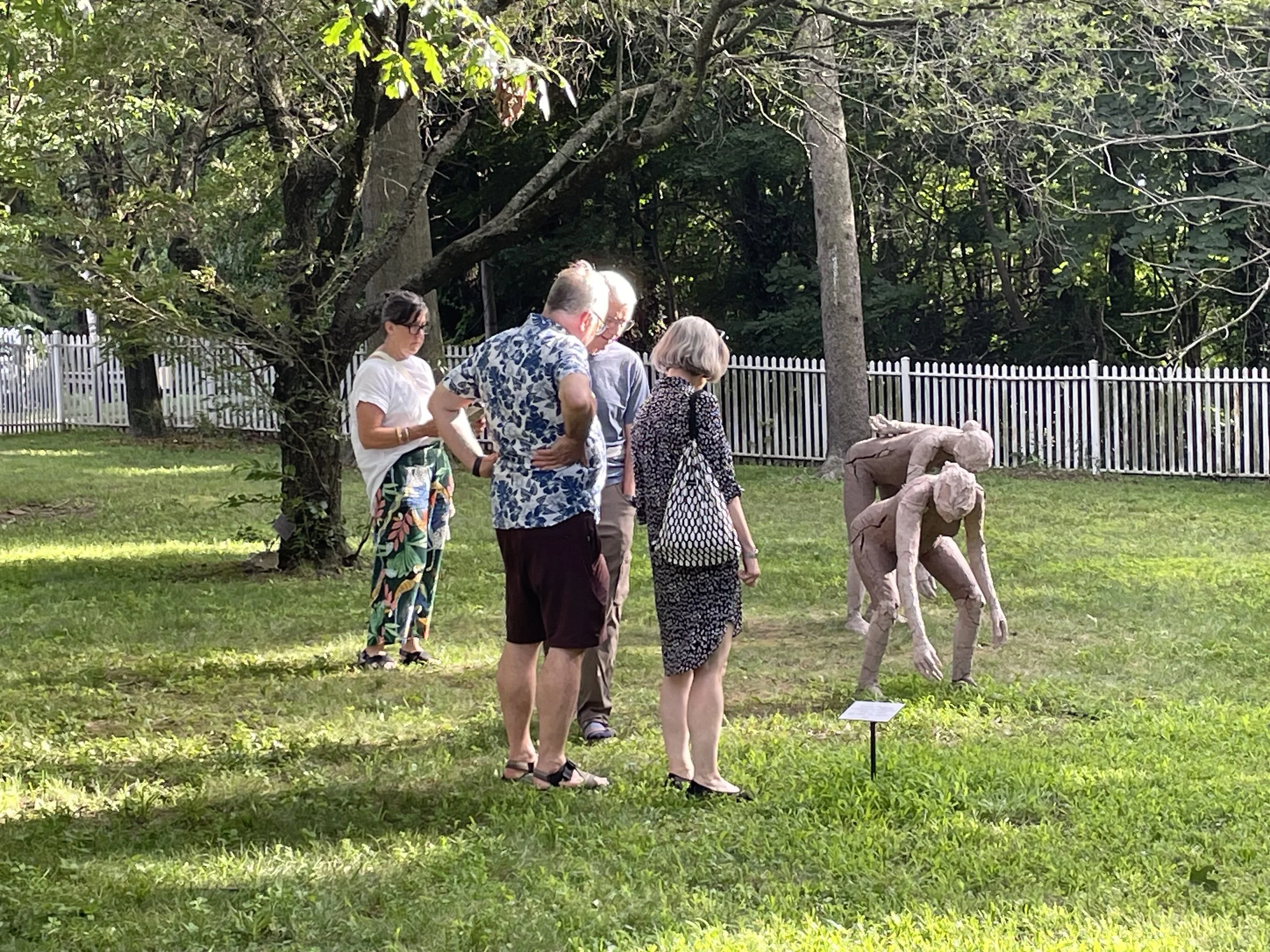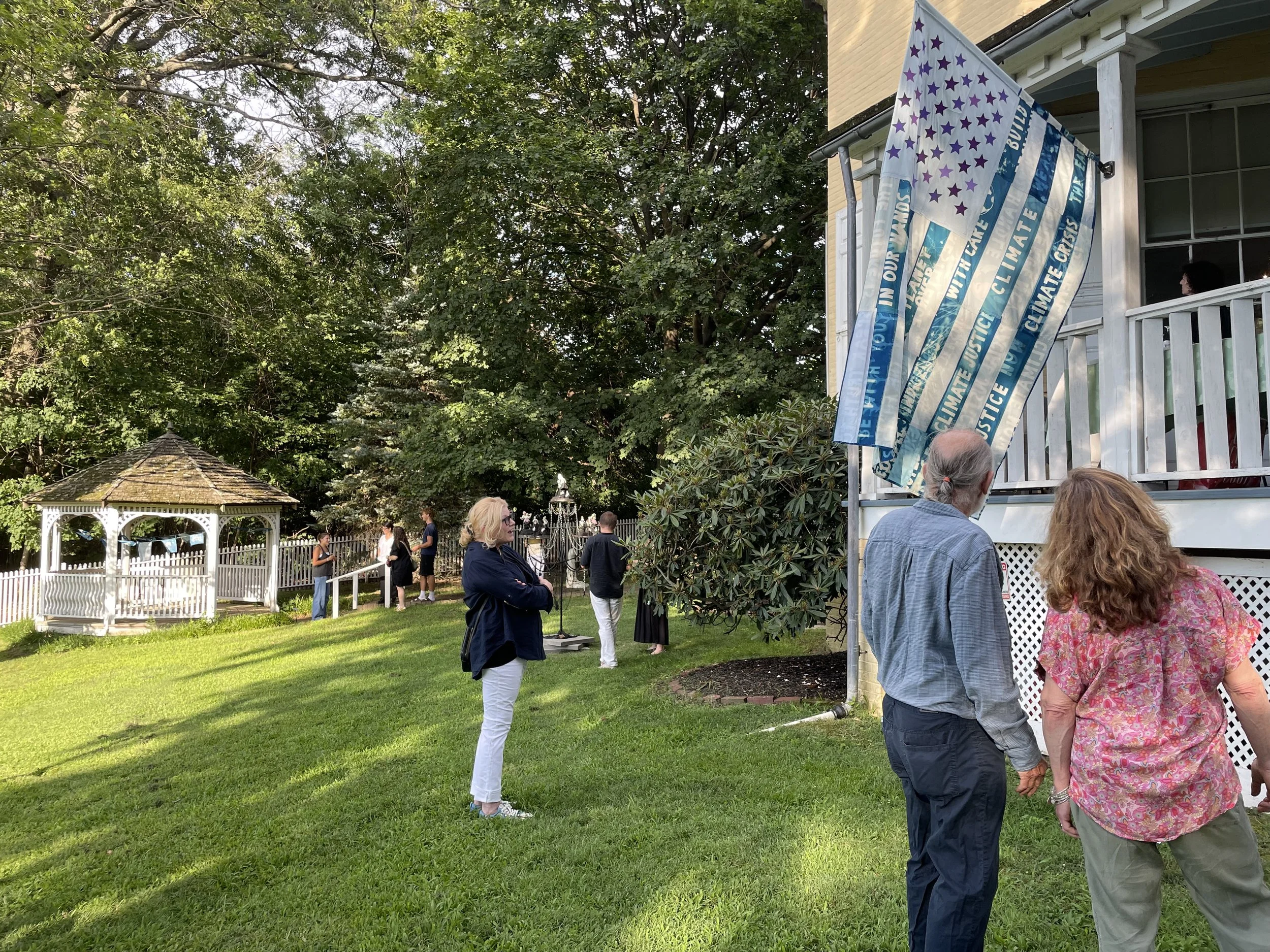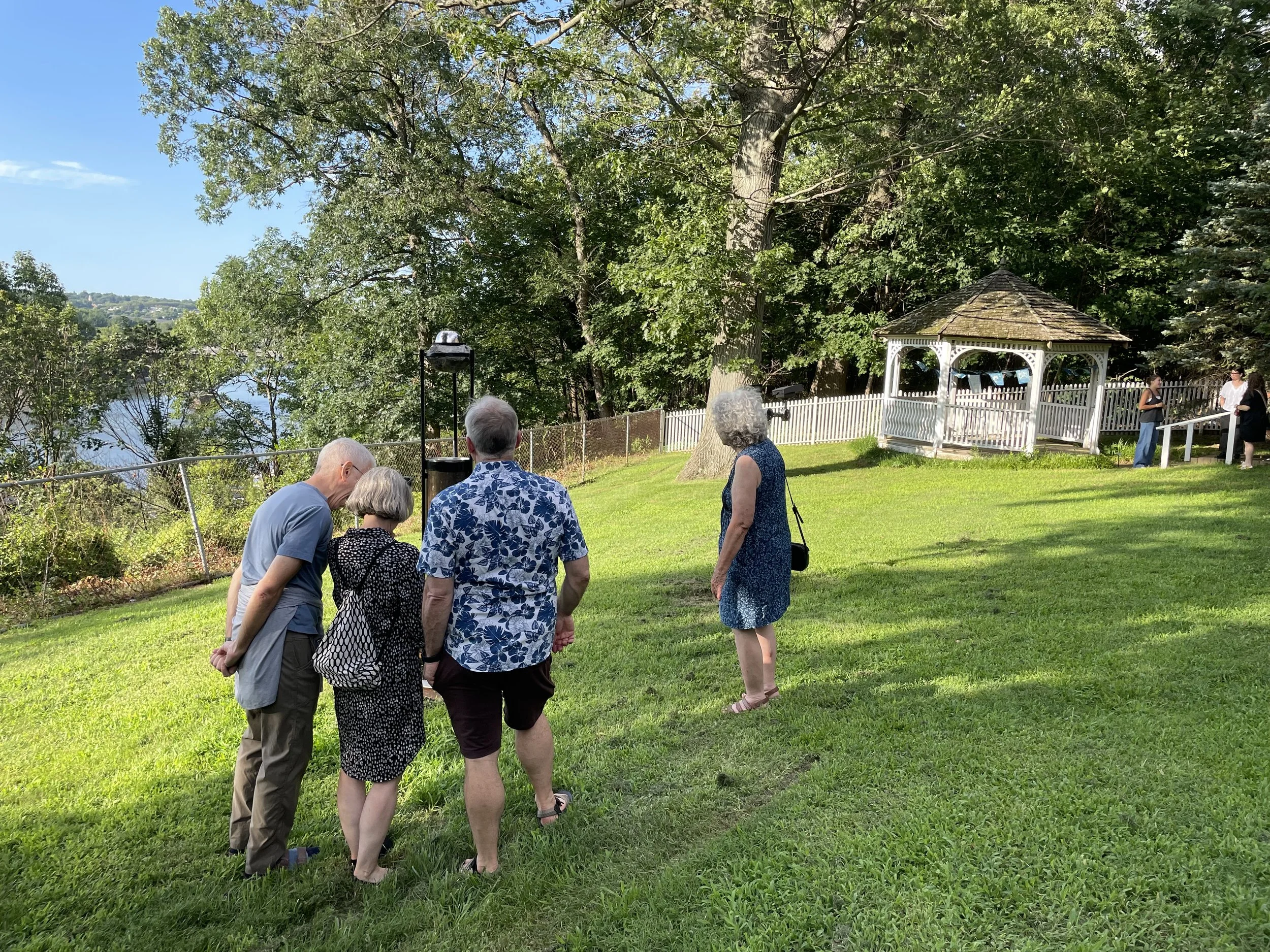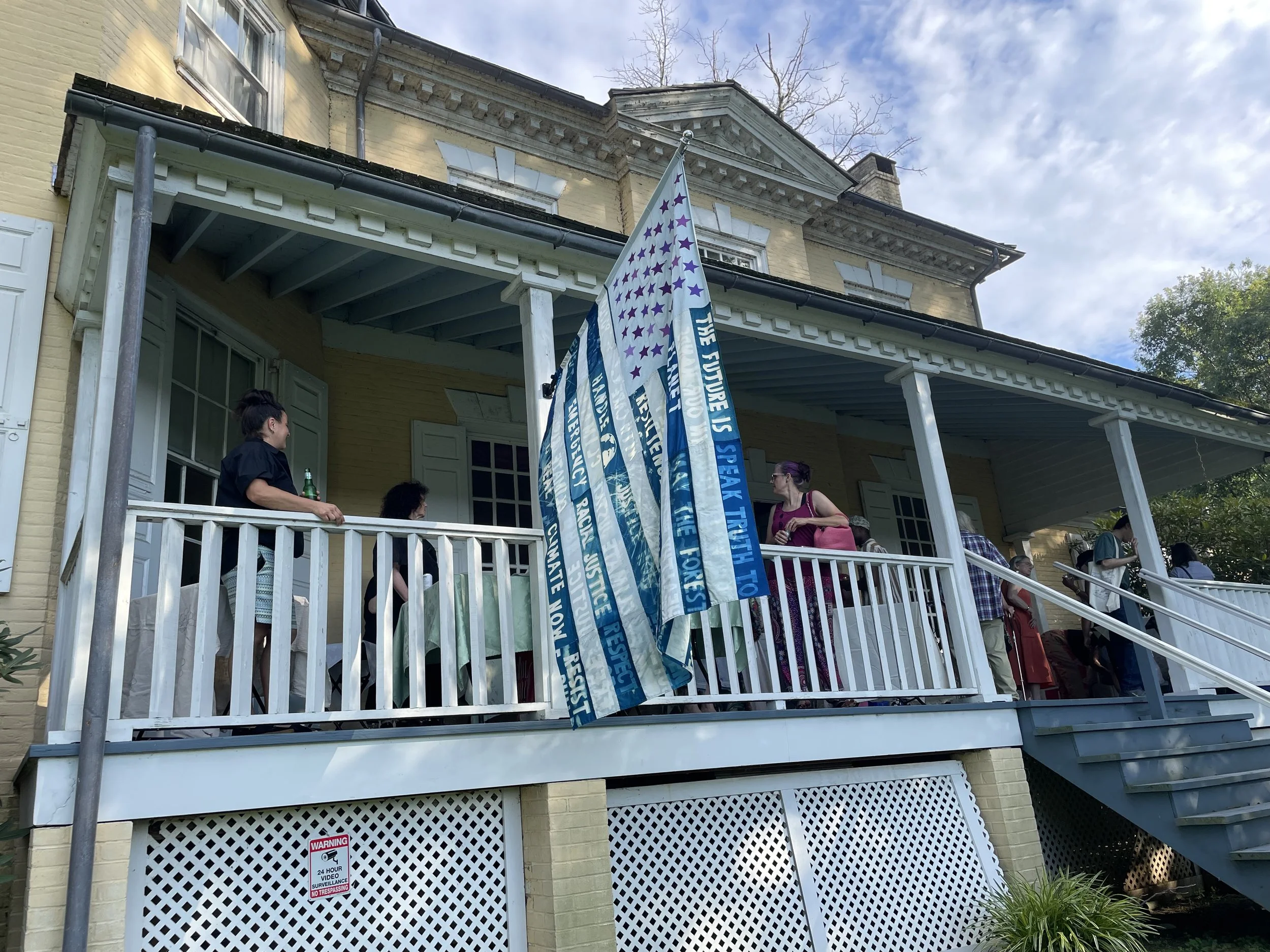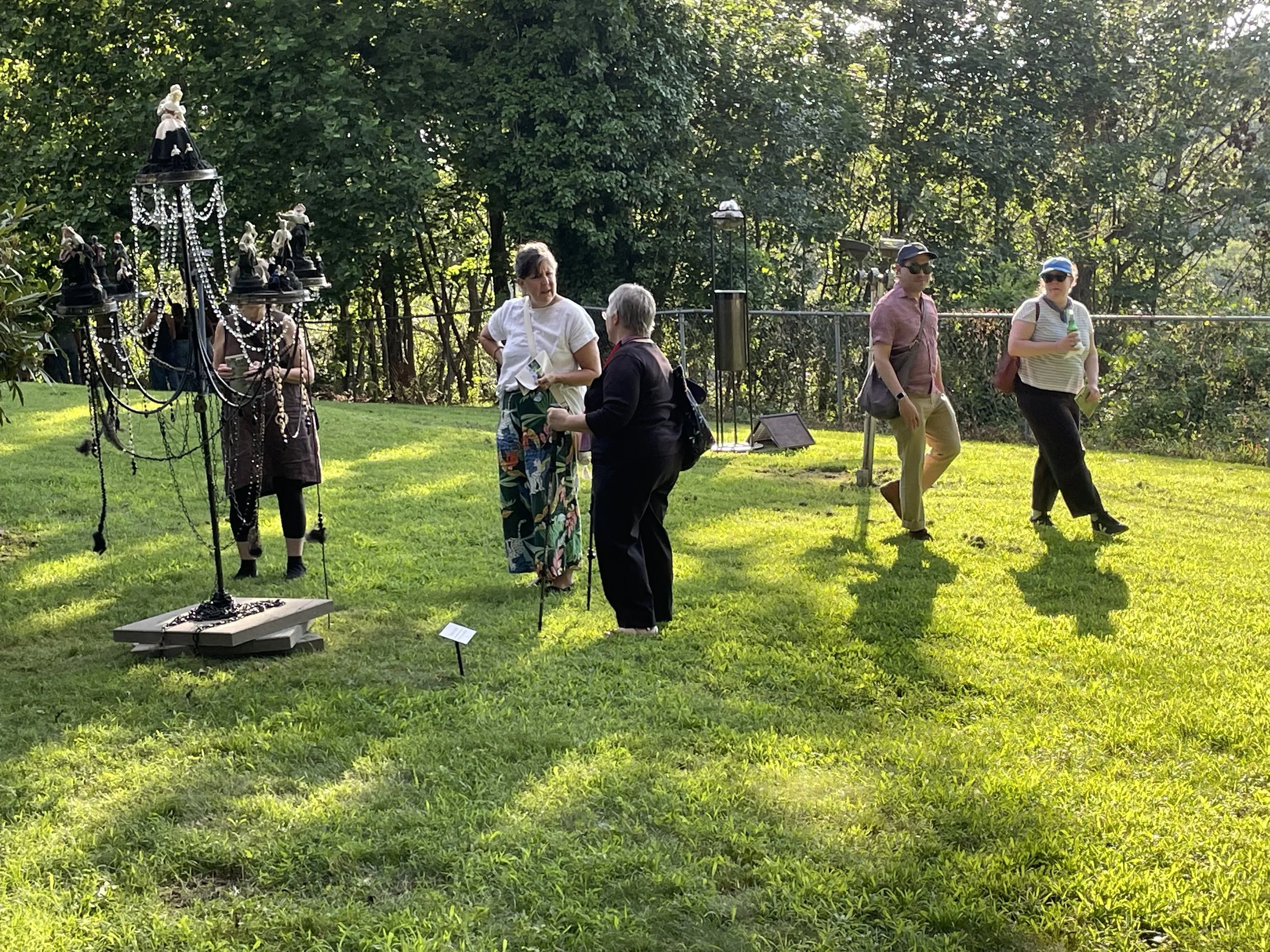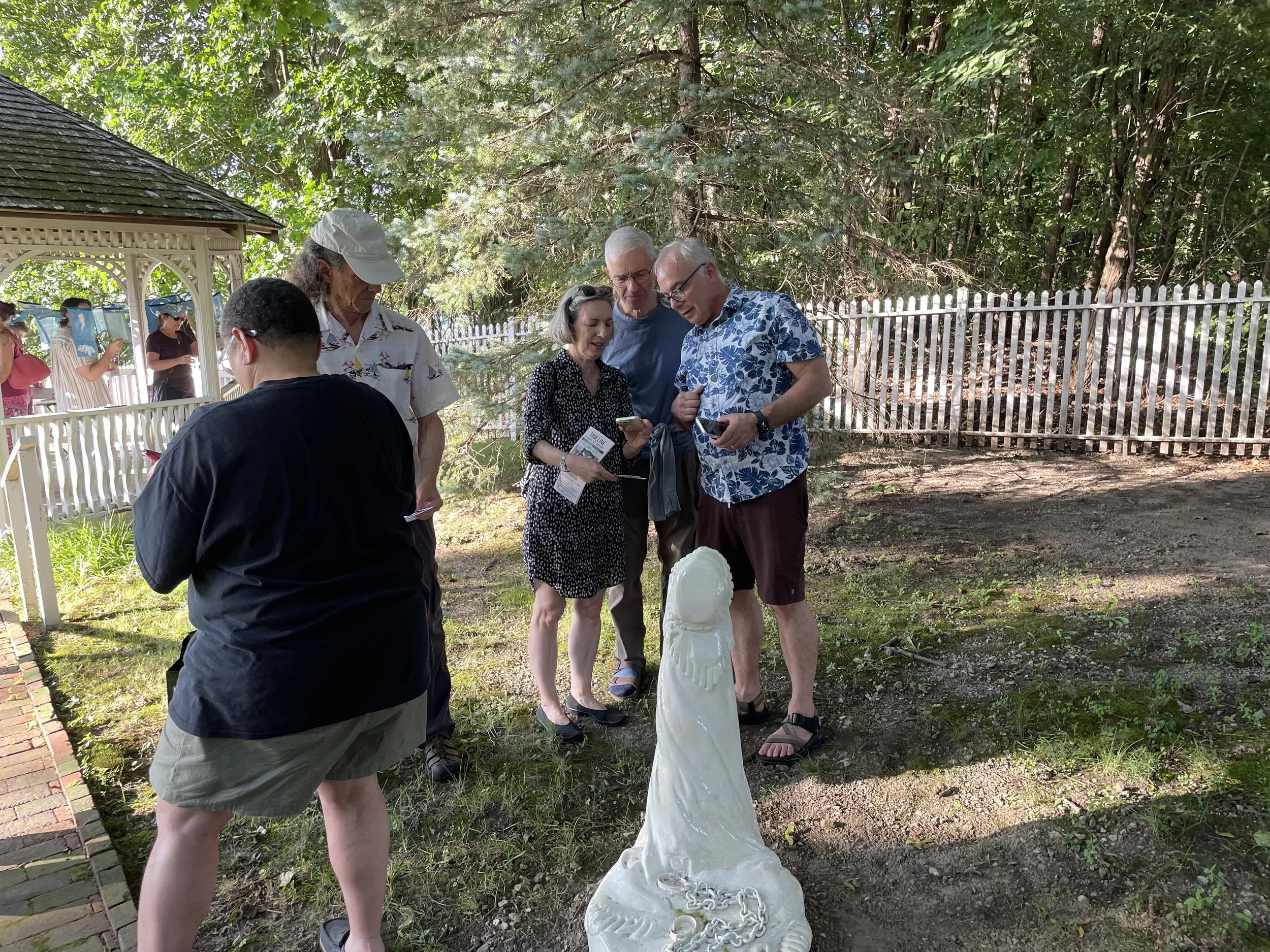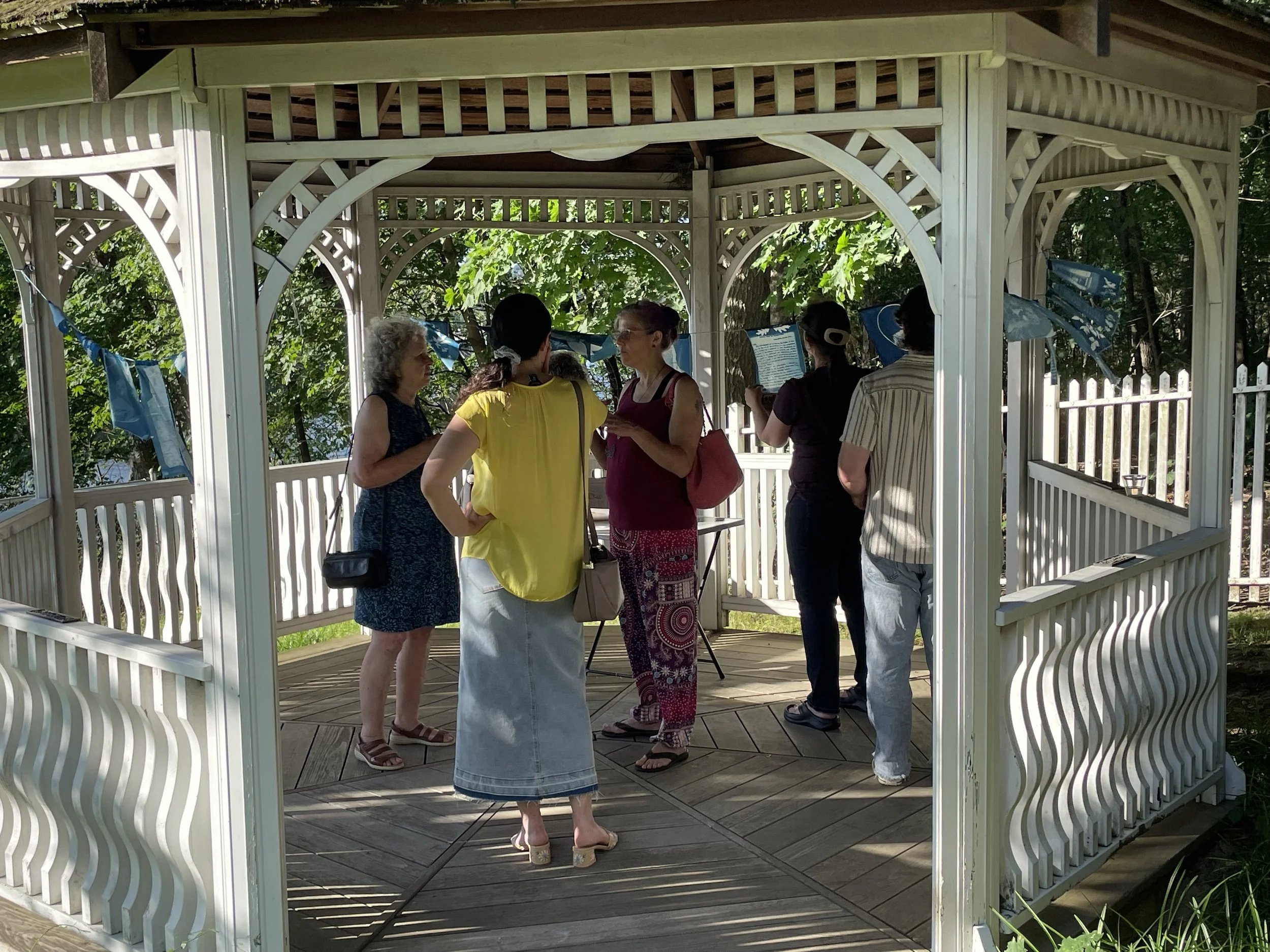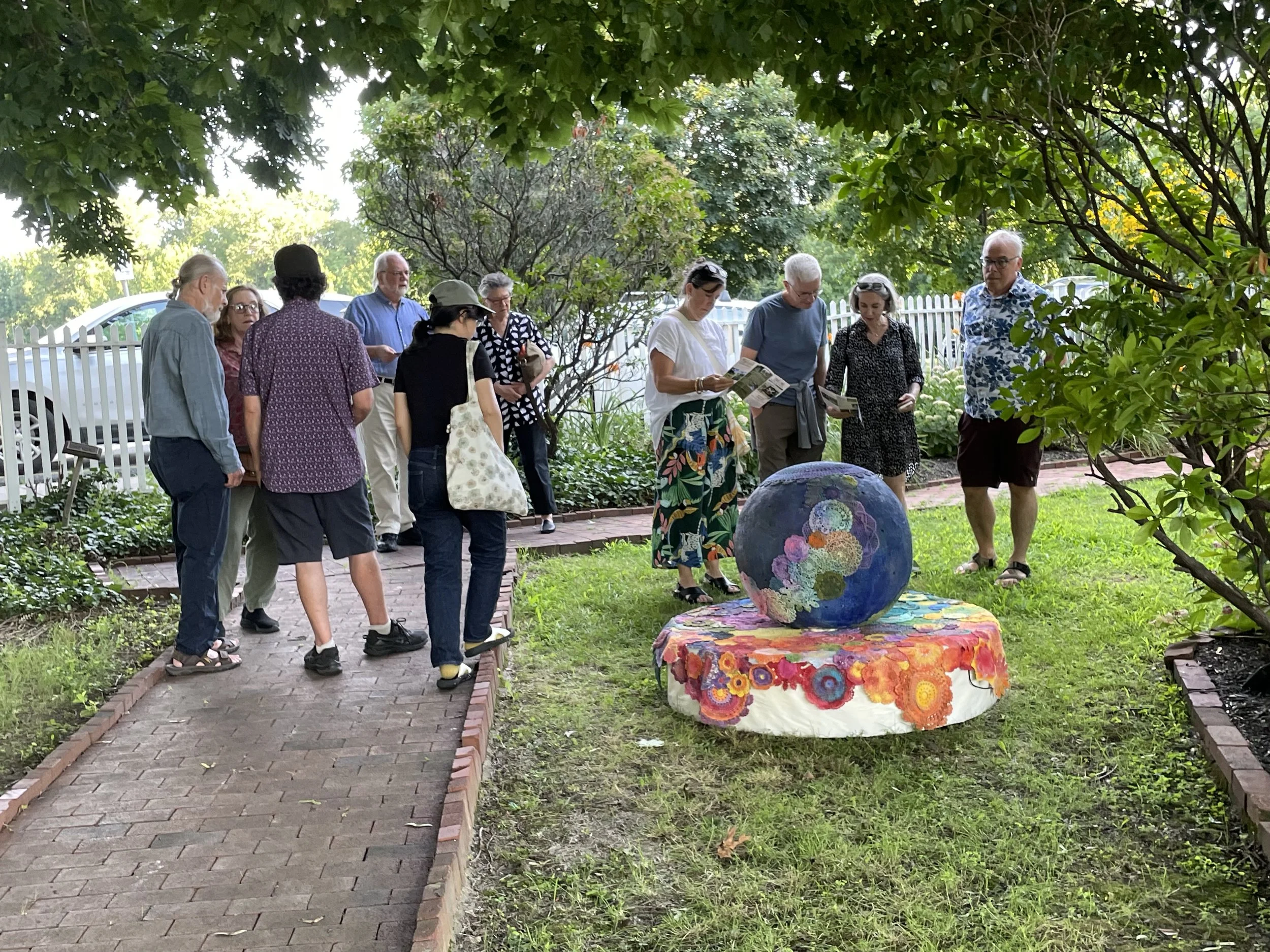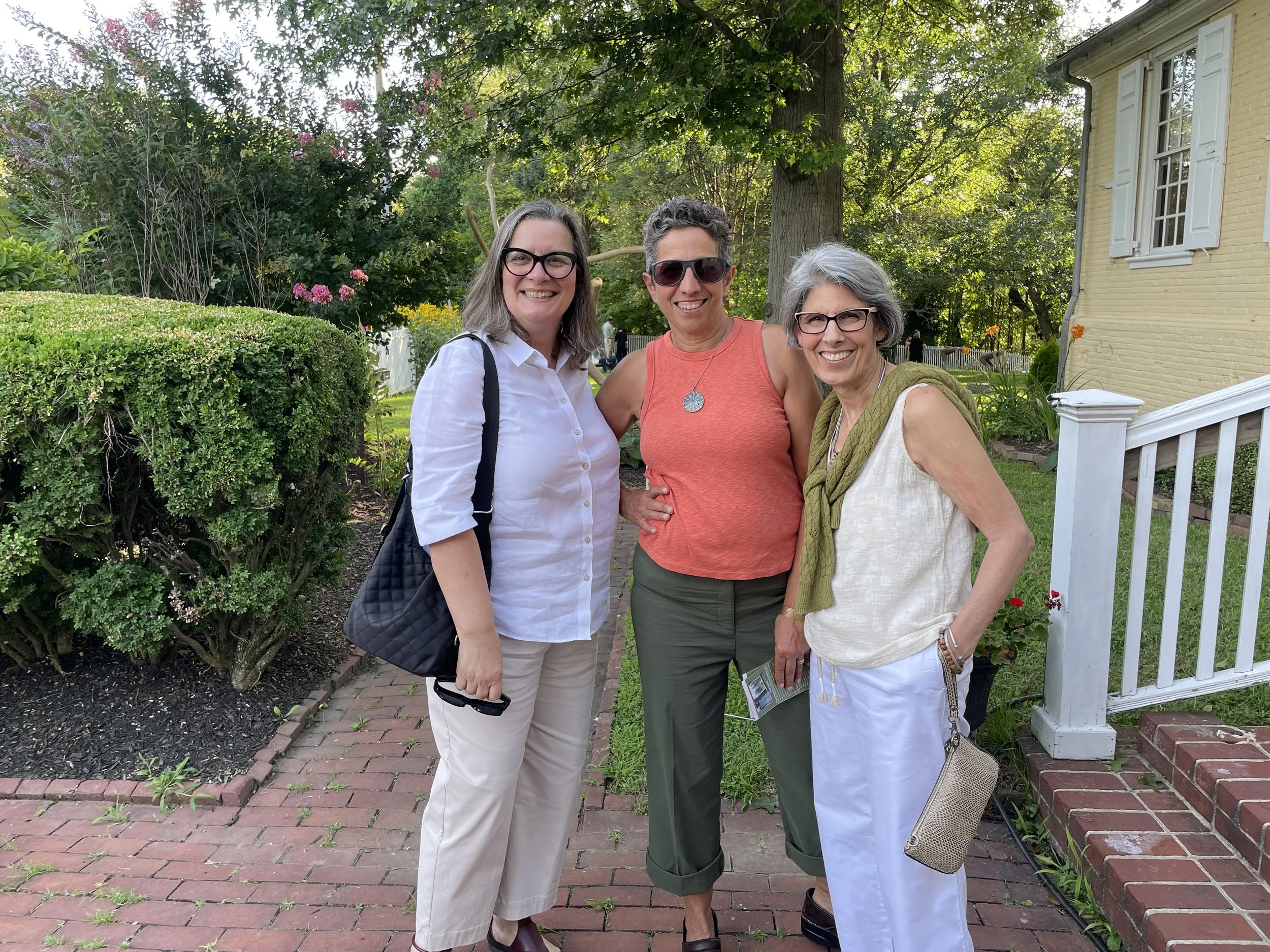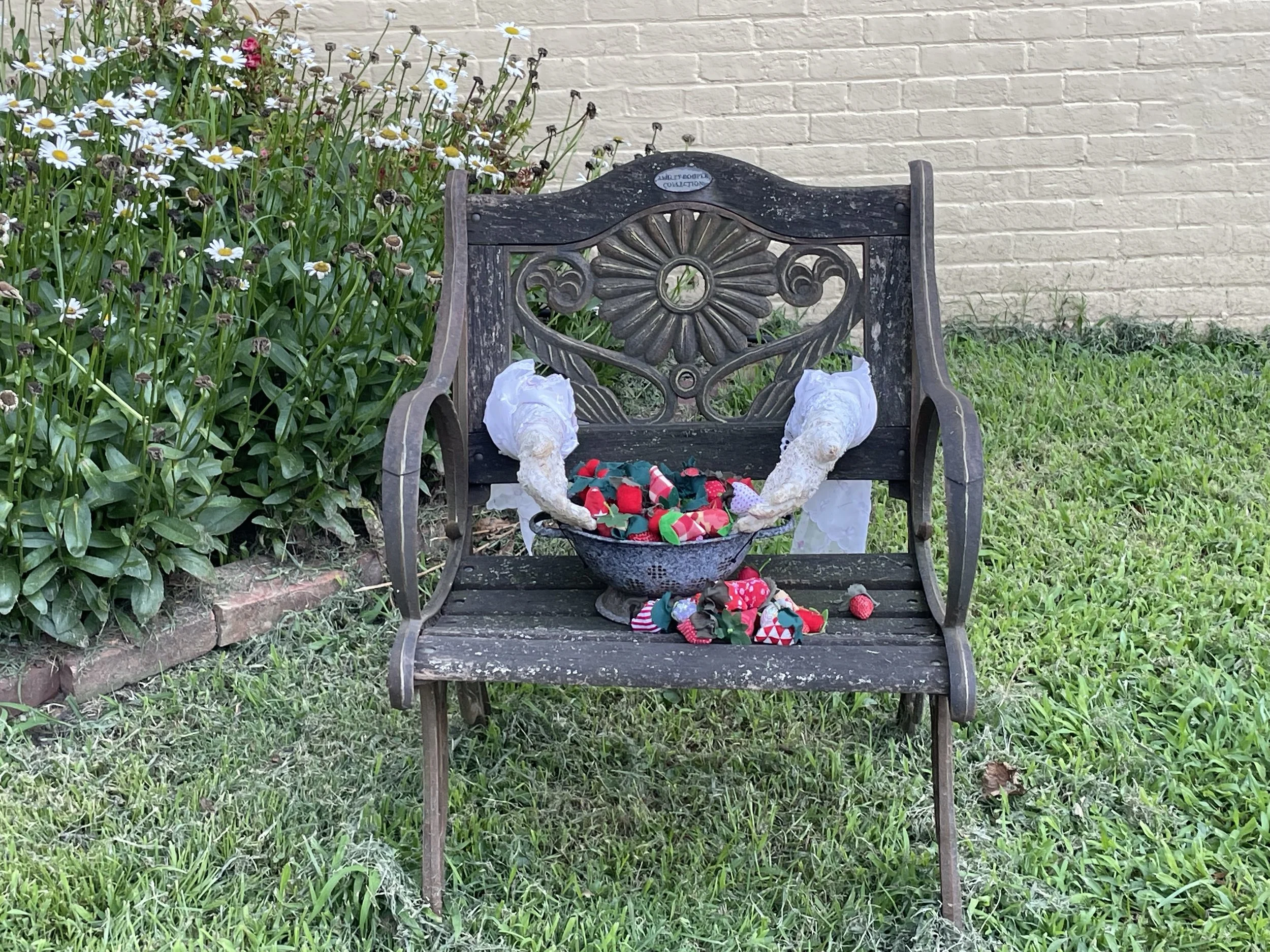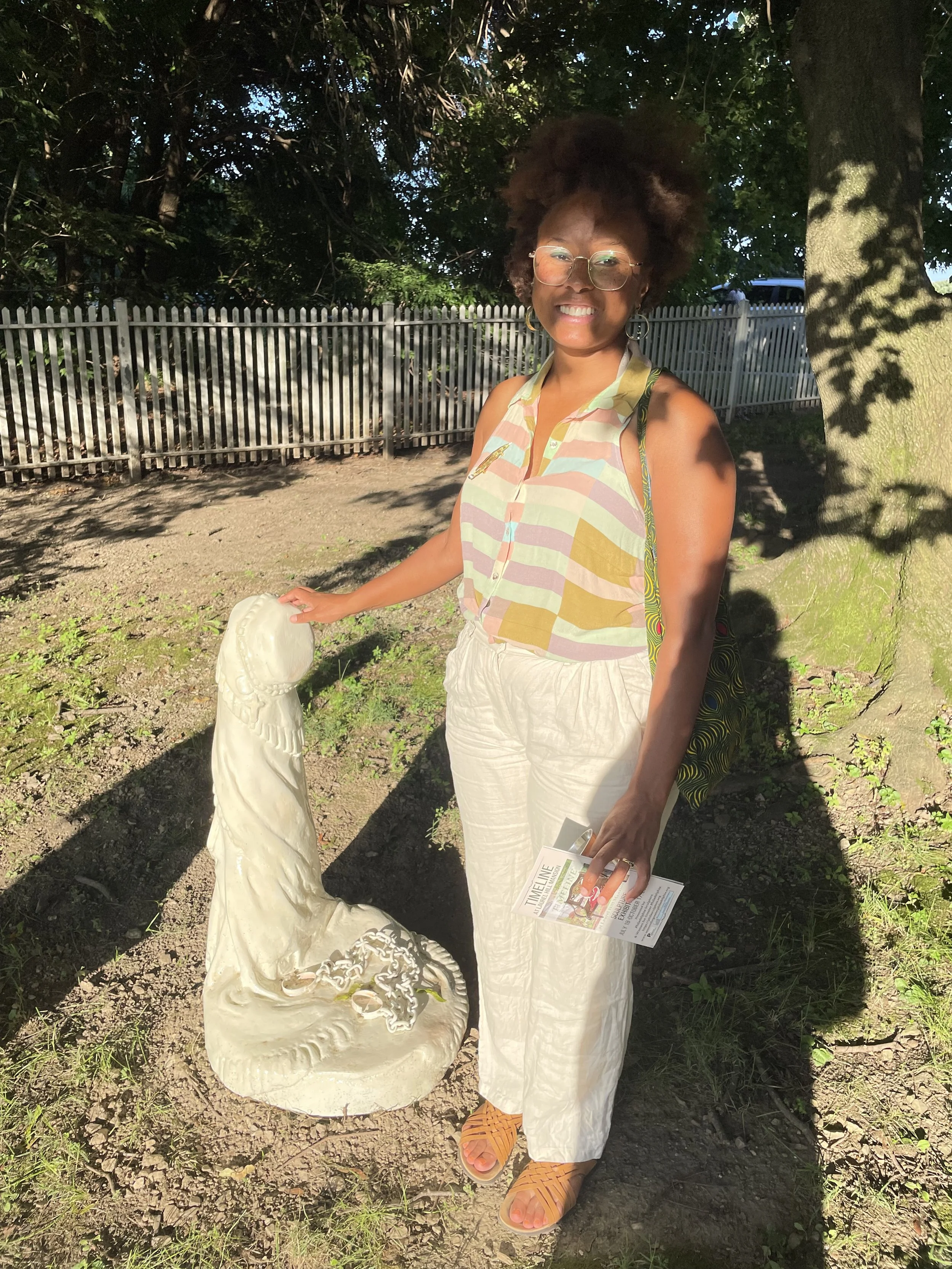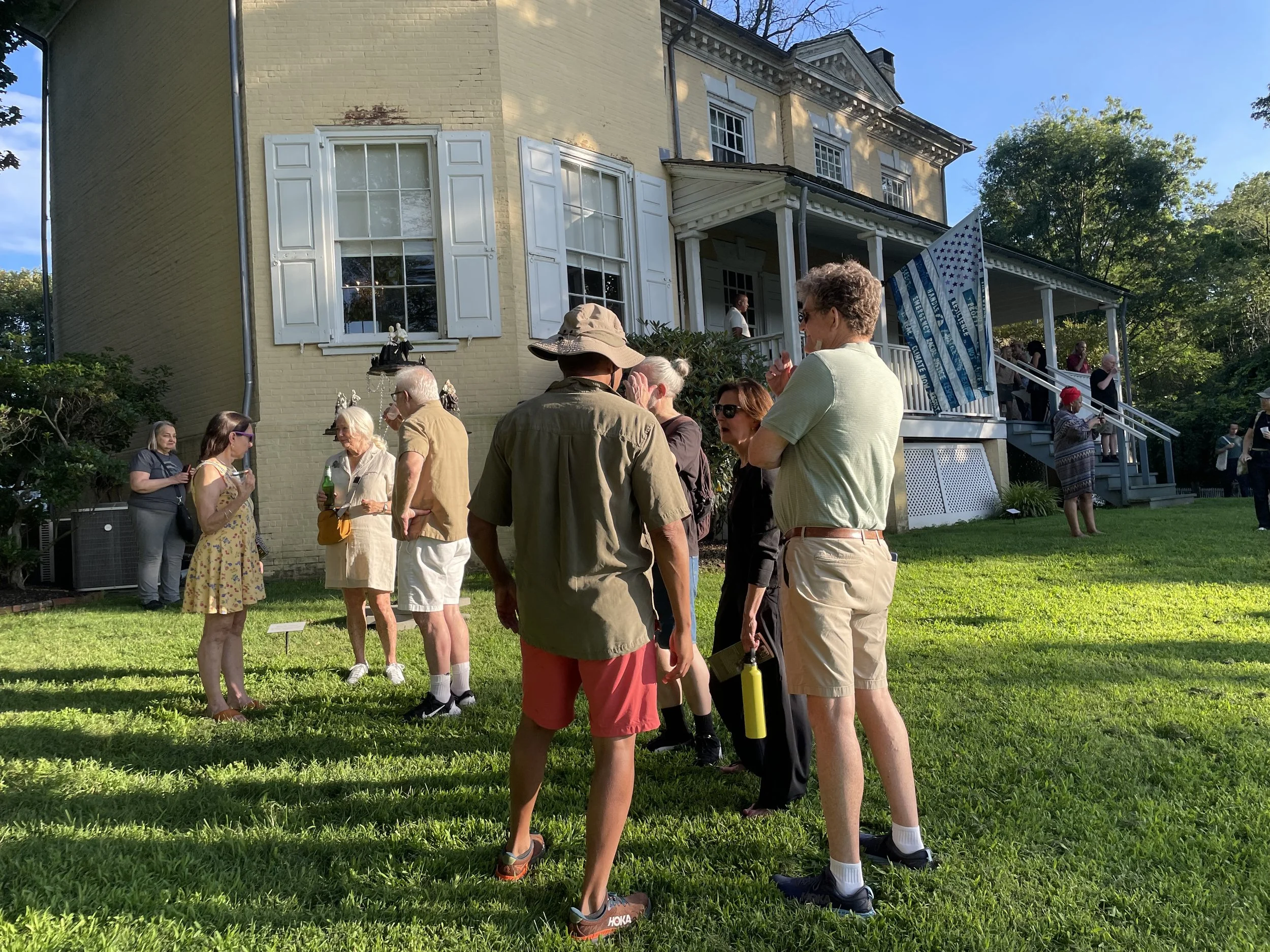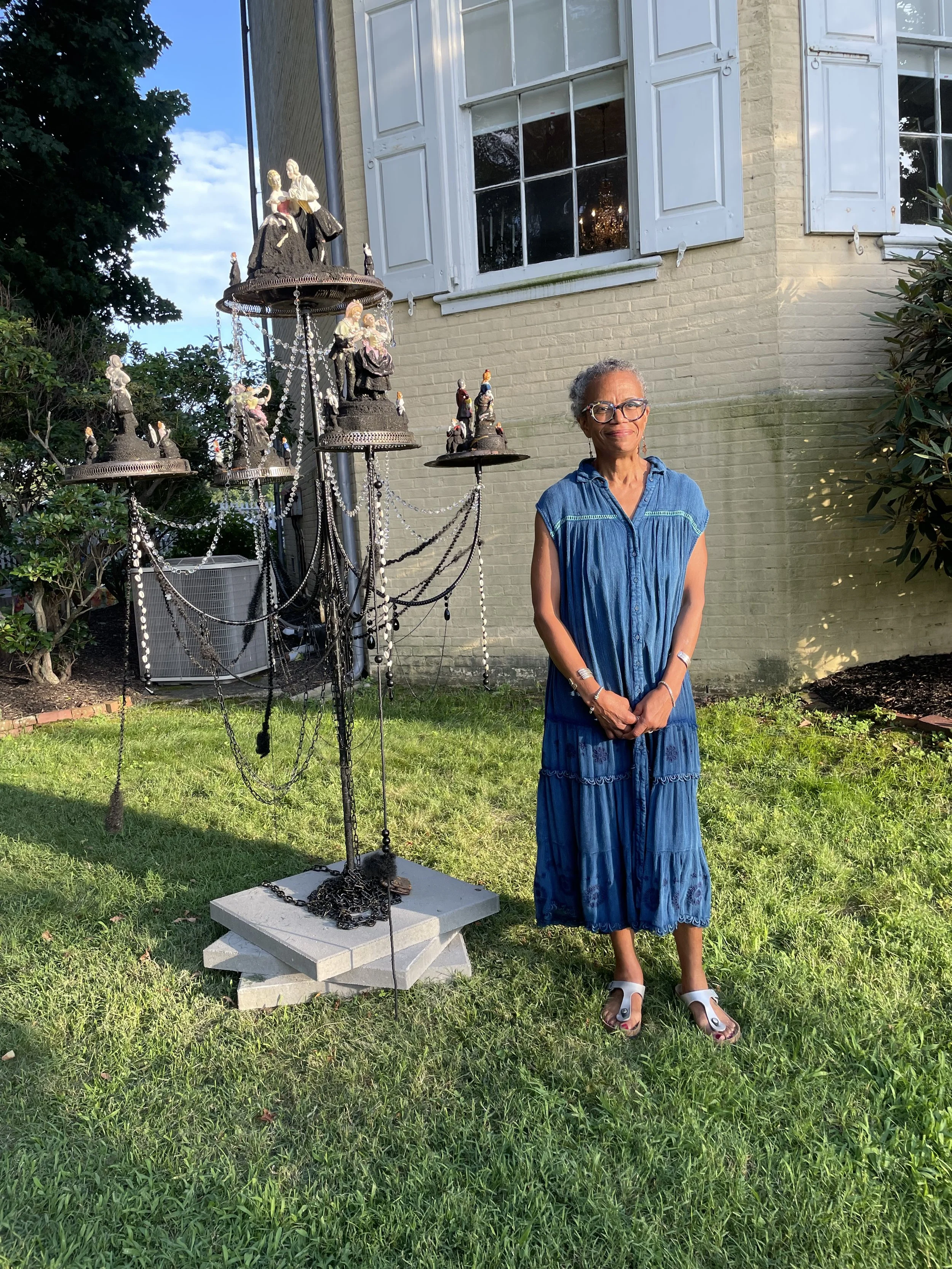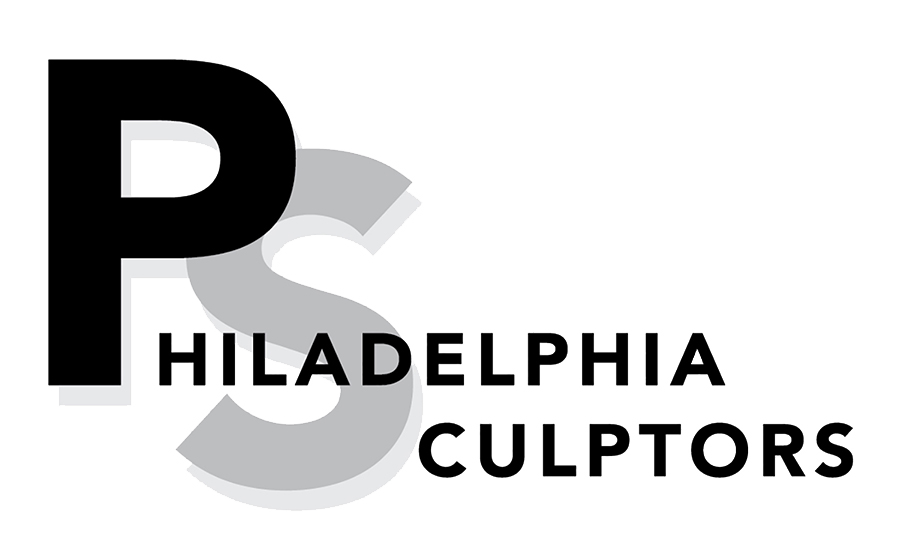TIMELINE
July 18 - October 17, 2025
Opening reception: Friday, July 18, 6 - 8 pm
Site hours: Thursday - Sunday, 10 am - 4 pm
Laurel Hill Mansion
3487 Edgley Dr., East Fairmount Park
Philadelphia
Philadelphia Sculptors and Women for Greater Philadelphia are pleased to announce the upcoming exhibition TIMELINE. This outdoor sculpture exhibition will be on view throughout the summer at historic Laurel Hill Mansion in East Fairmount Park, Philadelphia.
TIMELINE is a dynamic group exhibition that presents an expansive view of the panoramic Laurel Hill property and its history along the Schuylkill River. Artists selected by jurors Nancy Agati and Rachel Zimmerman proposed works that reflect the shifting, layered trajectory of the property, the mansion, and its stewards throughout history. Laurel Hill Mansion, located on a high bluff along the Schuylkill River, sits on lands that were inhabited for millennia by the Lenni Lenape. The land was acquired by William Penn in 1682 and the mansion, built in 1767, changed hands, structure, and purpose throughout the colonial era through to the present day.
With a focus on the past, several works in the exhibition address aspects of women’s rights to property; labor and farming; trade and commerce; slavery; and the abolitionist movement. Other artists integrate and connect contemporary viewpoints with historical concepts as they engage with broader themes including the passage of time, displacement, resilience, stewardship, and our human relationship to the land.
The property is currently managed by the nonprofit organization Women for Greater Philadelphia. This exhibition marks the kickoff for the series of events at Laurel Hill Mansion that will celebrate the nation’s Semiquincentennial in 2026.
Participating artists
Laura Frazure, Peggy Hartzell, Brenda Howell, Sam Horowitz, Carole Loeffler, Linda Lorrie Gross, Jessica Mungekar, Carrie R, Holly Smith, Simone Spicer, Julia Way, and Marisa Williamson
About the Artists
Carole Loeffler
Gathering Perseverance
Carole Loeffler is an artist, mother, and educator based in Philadelphia who imbues vintage textiles with the spirit of nameless foremothers to create narratives that reflect her lived experience. Drawn to old objects and textiles, she searches antique stores, thrift shops, estate sales, and eBay listings for pieces that whisper their histories—photographs with handwritten notes, worn quilts, and hand-stitched clothing marked by time and use. Through her work, she excavates, amplifies, andembellishes these stories, bearing witness to the matriarchs of the past. Carole holds a BFA from Mason Gross School of the Arts at Rutgers University and an MFA from the University of South Florida. She has exhibited her work in over 100 group and solo exhibitions across the U.S.
Gathering Perseverance honors the resilience of Rebecca Rawle Shoemaker, who sold strawberries for six years to reclaim Laurel Hill Mansion after being displaced during the American Revolution. Delicate, doily-covered hands represent both Shoemaker and the collective, often unseen labor of women across generations as they cradle a pile of sculpted strawberries—symbols of care, persistence, and the slow accumulation of effort. Installed on a weatherproof bench, the sculpture is built to endure the elements, echoing its themes of strength and renewal. Viewers are invited to take a strawberry, with new ones added throughout the exhibition, reflecting the ongoing cycles of labor, resilience, and reclaiming one’s place in history.
Linda Lorrie
Gross Yung-t'ung-mu: Wood of Glorious Paulownia
Linda Lorrie studied ceramics, fibers and sculpture at Tyler School of Art and the University of the Arts. Her work uses invasive plants as sculpture materials. Gross chose these materials due concerns about the environment and the caccessibilit to harvest them locally. Known as ‘the invasive artist’ Linda Lorrie has exhibited her work at the Delaware Center for Horticulture, Fleisher Art Memorial, Perkins Center for the Arts, Art in City Hall and Nexus, Foundation for Todays’ Art, among others. As a residency and workshop instructor she works with locally harvested materials in order to open a dialogue on the arts, history and the environment. Gross is currently a member of Muse gallery in Philadelphia with a solo exhibit in April, 2025. I am also a member of InLiquid Gallery and CFEVA.
Bringing a Paulownia sculpture to Laurel Hill completes a cycle of human cause and effect. My timeline considers the spread of invasive species through human activity, the cause, and its effects. Indigenous to China, where it has been cultivated for over 2000 years, Paulownia wood was used to build furniture, chests, musical instruments, and clogs. Its leaves and flowers were used ornamentally for crest and pattern design. But it was the tree’s woody seed pods that first brought paulownia to our shores. Each tree produces thousands of pods, and each pod carries thousands of seeds. Those pods were used as packing material for the Chinese export porcelain trade (1600-1900). Later, in the 1840s, Paulownia was introduced as an ornamental tree. You can see it growing around Logan Circle and in front of the Philadelphia Museum of Art. I imagine the dining and tea tables at Laurel Hill and surrounding estates were set with fine Chinese porcelain. In 1758 George Washington received his first shipment of porcelain, which he reported was “without any breakage”. That shipment was packed in crates padded with Paulownia seed pods. Once relegated to the dump, those pods released millions of seeds, some of which took root and spread. Today, because it is a very fast-growing tree that thrives in adverse conditions, Paulownia is sometimes considered an invasive species.
Holly E. Smith
Serpent in the Garden
Holly E. Smith graduated from Moore College of Art with a BFA in 1977. Her artistic endeavors include sculpture, painting, drawing, illustration, and writing. Her fine art work, for which she has won numerous awards, has been exhibited and collected throughout the United States, and is included in the permanent collection of Doylestown Hospital, PA, and the private collection of Johannah Hutchison, Executive Director of the International Sculpture Center, NJ. She has been a member of Philadelphia Sculptors since 1999 and acts as the group’s secretary and contributing editor of their annual newsletter. A resident of Philadelphia for 35 years, she now lives in Bucks County, PA amongst many friendly four-legged creatures.
With a nod to the biblical story, Serpent in the Garden references the Lenni Lenape being cast out of their traditional lands by European settlers. Replacing the apples in the original myth are the strawberries grown by Laurel Hill Mansion owner Rebecca Rawle.
carrie R
A static unfurling
carrie R (b. 1990, New Jersey) is a Philadelphia-based artist working in the mediums of sculpture and drawing. carrie received her BFA from Mason Gross School of the Arts at Rutgers University where she received a James O. Dumont Travel Grant Award. She has exhibited recently with Good Mother Gallery, Los Angeles, Putty’s Coronation, NYC, Cherry Street Pier at Delaware River Waterfront, and The Clay Studio Philadelphia, 5-50 Gallery and Field of Play, NYC , Commonweal and Blah Blah gallery Philadelphia,. carrie participated in the 2023 SPRING/BREAK Art Fair with 5-50 Gallery, and her work has been featured in Two Coats of Paint, Mister Magazine, Suboart Magazine, Munchies Art Club Magazine, and O FLUXO.
A static unfurling is a sculptural meditation on presence, movement, and the reclamation of space, particularly as it relates to women in the arts and public spheres. As a woman sculptor, I recognize the inherited constraints that discourage women from occupying space—physically, intellectually, and artistically. This piece embodies resistance to those constraints, capturing a form that appears to unfurl despite its stillness, a paradox that speaks to the ongoing tension between restriction and liberation. As someone who has endured and recovered from spinal injuries, I hold mobility and flexibility as privileges not to be taken for granted. This sculpture is a reflection of that—of expansion after limitation, of taking space unapologetically, and of honoring the body’s ability to move and persist. Through an electric yellow form that unfurls from a center column with curling appendages, the sculpture evokes organic movement, symbolizing both freedom and the limitations imposed on movement.
Laura Frazure
Poses of Labor
In all of my studio projects my comprehensive knowledge of anatomy allows me to construct a plausible three-dimensional figure derived from a photograph or rudimentary image, inventing structure by pushing and playing with bodily proportions. Most recently I've been referencing media images of women involved in protest activities or performing physical labor. I received my BFA from the Philadelphia College of Art and MFA from the University of Pennsylvania. I live and have a studio practice in Philadelphia and am currently teaching at Rowan University. I have taught at the University of the Arts, the University of Pennsylvania, The New York Academy of Art, the Central Academy of Fine Art, Beijing and the Tianjin Academy of Fine Art, Tianjin, China. I am a nationally and internationally exhibiting artist with works shown in Asia, Europe and throughout the US. I have received two Pew Fellowship Disciplinary Awards, three Faculty Research Grants from the University of The Arts and the Robert Engman Award from the University of Pennsylvania. My work is in notable collections, including Nader Tavakoli, New York, and Witold Rybczynski, Philadelphia. I am included in Reinhard Fuchs’, Women in Art, Volume 1, 520 Masterpieces of Visual Art, The Great Female Artists: From The Middle Ages to the Modern Era. In 2024 I received the President’s Distinguished Teaching Award from the University of the Arts, where I was coordinator of sculpture.
Poses of Labor, inspired by two figures in The Gleaners (1857), a painting by Jean-François Millet, depicts women gathering the remains left in the field after the harvest is completed. The women portrayed were the most vulnerable members of the community and functioned as a social safety net at the time. The poses could also be interpreted as immigrant farm laborers from contemporary times or simply experienced as the body performing a physical task relating to the earth. The sculptures were modeled by volunteers who created the bodies through consensus. They will dry out, crack, weather, and disintegrate as time passes.
Simone Spicer
The Guardians of Laurel Hill
Simone Spicer is a sculptor based in Wyncote, PA with a career that includes a BFA in Sculpture from the Maine College of Art, an MFA from the University of North Carolina, and a full scholarship to The Skowhegan School of painting and Sculpture. Spicer’s work has been exhibited in our area at the Philadelphia Museum of Art, the Independence Seaport Museum, the Woodmere Museum of Art, and the Philadelphia International Airport. She is an active member of the Philadelphia Dumpster Divers, Philadelphia Sculptors, Inc., and is affiliated with a group of artists/activists in NYC who exhibit together and collaborate with scientists to address climate change through art.
The Guardians of Laurel Hill, is comprised of three loosely humanoid, female forms inspired by the intriguing history of Laurel Hill Mansion and its landscape. As hollow forms of clothing, these figures represent, through dress, a timeline around the mansion’s existence from native Lenape habitation through colonial settlement, Victorian era and contemporary time, and honor the powerful women who, against adversity over centuries, have been stewards of this land and building. The gauze material and aluminum screening support my strong attraction to the ethereal and thoughts of impermanence. Their transparent quality creates a ghost-like, fairy- like, guardian angel-like effect because these figures are about the invisible forces behind the elements that drive evolution, change, and the cycles of life. They are spirit protectors who come to remind us of our interconnectedness.
Sam Horowitz
Precipitation Study #1 (Bringing the Mountain to Mohammed)
Sam Horowitz is a futurist, mad scientist, and Assistant Professor of Sculpture at Rowan University. Horowitz has exhibited in solo and group shows throughout the US, and earned degrees from Alfred University (MFA, ‘20) and Bard College (BA, ‘10). He serves as the Deputy Director of Exhibitions for the 2025 National Conference on Contemporary Cast Iron Art and Practices in Alabama, and is a member of the Artistic Committee of Franconia Sculpture Park in Minnesota. Horowitz has held a number of artist residencies, including those at Salem Art Works (NY), on Governors Island (NYC), and at Sloss Furnaces (AL). Horowitz was named a 2025 Fellow in Sculpture by the New Jersey Council on the Arts. In the studio, Horowitz builds with metal, stone, wood, glass, and co-opted natural processes to create sculpture-as-metaphor to purvey a sense of empathy and awareness, and to strengthen perceptions of our actions in an accelerating world.
The concrete crown of this fountain is mixed with a 10% lime composition. A fountain pump lifts water from a hidden basin up one of the legs, filling the crown at a slow trickle. This water leaks out of minuscule cracks, running down the face of the concrete form and leaving mineralized records of its passage. Over time, the water pumped through this work will precipitate out more of the excess mineral, growing a stalactite from where it drips back into the reservoir, and flowstone where it runs along it. While this process is much accelerated from a natural occurrence, it still takes long seconds for each drop to fall, challenging viewers to expand their frames of reference and appreciate their time today.
Julia Way
For the Future, 2025 (Flag Version)
Julia Way creates artwork rooted in a deep connection to the natural world, using observation of local ecologies as a foundation for her practice. Through a diverse range of media—including outdoor installations, video, and watercolor painting—she explores the intricate systems and relationships that define the environment around her. By translating these intimate perceptions into physical forms, Way seeks to bridge the human experience with the natural world in ways that invite reflection and dialogue. Her work has been showcased at numerous prestigious venues in the Philadelphia area, including the Schuylkill Center for Environmental Education, Woodmere Museum of Art, the Francis Cope House at Awbury Arboretum, and the Maguire Museum at Saint Joseph's University. These exhibitions highlight her commitment to engaging with both nature and community through art.
For the Future was originally an outdoor art installation of 50 cyanotype fabric banners that I completed for the Schuylkill Center for Environmental Education for an exhibition to celebrate the 50th anniversary of Earth Day in 2020. The messaging on the banners is a collection of phrases and slogans from actual signs displayed at protest marches in the United States over this 50 year period. For this project, I have repurposed those banners to assemble an American flag. The 50 stars represent each state in alphabetical order. The shade of purple indicates how “blue or “red” each state has leaned in the last 5 presidential elections. While denial of the climate crisis unfortunately often follows party lines rather than scientific data, the reality we find ourselves in requires us to focus on restorative practices to move forward rather than argue whether the problem exists in the first place. Forward progress depends upon upholding knowledge in the face of suppression. For the Future, 2025 (Flag Version) seeks to bring light to the known conflict within the environmental issue in order to move past this obstacle and put energy into solutions. The climate crisis is a worsening underlying issue affecting many other social challenges of our day.
Brenda Howell
So what happened was…,
Brenda Howell has explored her passion for color, texture and beauty through different materials and mediums. Initially focused on Fiber Art a chance encounter with an encaustic artists opened a whole new world of exploration. A principle theme in Howell’s work is her faith and social justice issues. Her desire is not for a didactic art but to create work which makes the viewer question long held assumptions or views of history. Her work has been described as gritty and unsentimental. Brenda has a BA from the University of Pennsylvania and has taken coursework at Temple University, Tyler School of Art and Syracuse University. Her work has been included in juried exhibitions throughout Pennsylvania and New Mexico and is included in public and private collections. She is a member of Artessa Alliance, DaVinci Art Alliance and the Cheltenham Center for the Arts. Brenda lives and maintains a studio in Philadelphia, PA.
So what happened was…, when you hear someone say this, you know you're about to hear a long, complicated story, — full of twists and turns. Such is the history of slavery in the United States. Many trace the beginning of slavery in America to 1619, when the privateer The White Lion brought 20 enslaved Africans ashore in Virginia. Eventually, an estimated 12.5 MILLION Africans would be forcibly transported to the Americas —a number that underscores the vast scale of this human tragedy. My installation invites viewers to confront that staggering reality—and the arrogance of those who believed human beings could be treated as chattel, incapable of rising up to claim their dignity and freedom. It challenges us to dig deeper into the layers of America’s past, revealing the roots of institutional racism, the lasting impact of generational wealth, and the psychological trauma. The figurines in this installation symbolize a sanitized, often naïve version of American history—a kind of magical thinking that glosses over the brutal truths of slavery. But the echoes of that past reverberate still. As this painful history unfolded, the Rawle family—occupying Laurel Hill from the 1760s through the early 1800s—can proudly point to their role in the abolitionist movement. Their Quaker beliefs in equality and non-violence are a lasting legacy and a reminder that even in the darkest chapters of our history, there were those who chose to stand on the side of justice.
Peggy Hartzell
Esther DeBerdt Reed, A Hidden Past Brought to Light
Gen. Joseph Reed and Esther De Berdt Reed are my 4th great grandparents. My grandmother was a Washington and my grandfather was a direct descendant of Bishop Wm. White so I grew up with lots of Philadelphia history except it was mainly about the male ancestors and not the women. I have taught art programs at Yellow Springs, Henderson High School and at Crested Butte Wildflower Fest in Colorado. My art work has over the years included the natural environments and the local history in Northern Chester County near Warwick Furnace. I believe we all continue to be a part of an ongoing living history.
My work celebrates little-known strong women who supported the troops and the fight for independence while raising families during the American Revolution. Esther DeBerdt Reed’s husband, Joseph Reed, joined Washington as his Aide in June 1775. Five years into the war she gave birth to a 4th child while organizing with other women to raise money to support the troops in the fight for Independence. Inspired by the broadside "Sentiments of an American Woman", anonymously published by Esther Reed on June 10th, 1780, women began going door to door to collectsmall donations. By July 4th, they had collected $300,000 to show women’s support for the men fighting at war. That summer, Esther, her mother, and her children moved to Laurel Hill Mansion to escape the heat and diseases of the city. Nature and the river view brought them comfort, peace, and resilience for the work of sewing linen shirts for the troops. Her husband Gen. Reed was at that time stationed in NJ. Esther returned to the city at the end of August to see her husband, but contracted dysentery and died at the age of 33. My Cyanotype prayer flags, made with sun and nature, portray Esther’s final days, her letters, and her work at Laurel Hill with her young children. They demonstrate the continued restorative effects of the river view, birds, trees, and plants, especially in these trying times, as you walk and enjoy this peaceful property 245 years later.
Marisa Williamson
The Greek Slave
Marisa Williamson is a project-based artist who works in video, image-making, installation and performance around themes of history, race, feminism, and technology. Her work has been featured in exhibitions throughout the US, as well as Rome, Berlin, Switzerland, and Buenos Aires. Williamson’s work has been awarded grants from the National Endowment for the Arts, Charlottesville Area Community Foundation, Virginia Humanities, The Graham Foundation, Rema Hort Mann Foundation, and the Arthur and Elizabeth Schlesinger Library on the History of Women in America. She was a 2012 participant in the Skowhegan School of Painting & Sculpture and the Whitney Museum’s Independent Study Program in 2014-2015. Williamson holds a BA from Harvard University and an MFA from CalArts. She is an Assistant Professor of Visual Art at the University of Virginia with a research focus on Blackness. Recent projects include the creation and management of Unsettling Grounds, a project-based artist residency for which local BIPOC artists proposed virtual monuments housed in an augmented reality mobile application site-specific to the Historic Charlottesville Woolen Mill. Unsettling Grounds was supported by an NEA OurTown grant. She is developing installation, performance, and digital projects in Charlottesville and nationally that invite questions about how the historical landscape is marked by certain narratives while others remain buried.
The middle-aged, Black, female artist’s body is styled, posed, and imaged in the round to produce an uncanny life-sized 3D stand-in for Hiram Powers’ 1844 marble statue, The Greek Slave. On the Laurel Hill site, visitors see a fabricated version of the pedestal on which Powers’ slave stands, with discarded chains and cuffs. Use the QR code or visit looseslave.com to view the augmented reality figure as though it were a physical sculpture through the narrow window of your smartphone. Powers’ The Greek Slave was the first, publicly exhibited, life- sized sculpture of a nude female figure created by an American sculptor. It took on meaning for abolitionists leading up to the Civil War. Nudity in art ran counter to the mores of the time. Anticipating controversy, the artist used the iconography of chains, a crucifix, and a locket to shield the woman from judgment. Despite initial shock, the public came to see her as a vulnerable and dignified figure, a modest Christian, a beloved but objectified woman trying to hide herself. William Wells Brown, the formerly enslaved writer, used the statue to mount a protest at the 1851 World's Fair. He placed a caricature of The Virginian Slave (a Black woman) at its feet.
Jessica Mungekar
I am Woman
Growing up in Philadelphia, Jessica was surrounded by artists and their creative processes, fosterering a deep appreciation for the craft. She earned her BFA from The University of the Arts and the Pacific Northwest College of Art (PNCA) before completing her MSW at Temple University, then working as a Licensed Social Worker in NJ. In 2018, she began drawing on her fine arts background, and discovered sculpting with cement. Captivated by the medium, she created indoor vessels, later expanding into sculptural spheres. Jessica is committed to community engagement through art. She’s invloved in collaborative projects, workshops, commissions, and exhibitions, Jessica continues to bridge the gap between art and community.
In Philadelphia, a city shaped by revolution and quiet resilience, the sphere and the doily speak to the layered histories of women. The sphere—strong, independent, and stable—mirrors the hope women had based on the promise of liberty offered, but not always fully granted, to women. Especially those marginalized by race or class. The doily, delicate yet enduring, reflects the often-overlooked labor of women who held the city together—sewing, teaching, caregiving, organizing—one quiet act at a time. Together, lifted onto a pedestal and layered in color, these symbols reveal a deeper Philadelphia—one shaped not only by declarations and battles, but by women who carved out space within constraints, wove strength from softness, and stitched their presence into the very fabric of the city.
Installation images
